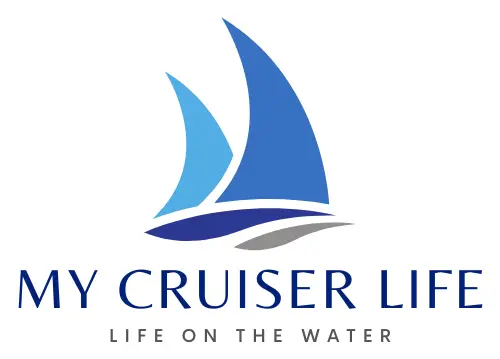
My Cruiser Life Magazine

17 Best Sailboats to Live On + What You Should Know First
Many dream of living aboard a sailboat, but finding the right one can be daunting. There are many different types, and countless manufacturers have come and gone over the years.
Here’s a list of 17 options – a sailboat for every sailor on every kind of budget.
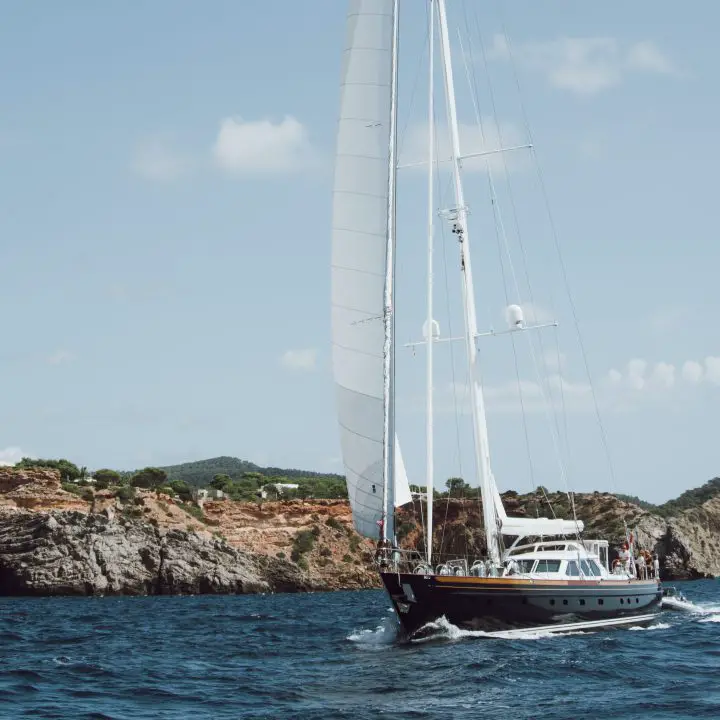
Table of Contents
17 best sailboats to live on, pros of living aboard a sailboat, cons of boat life.
- Find Your Type of Boat
Set Your Boat Budget
What size boat to pick, best liveaboard sailboats under 35 feet (< 35 feet), best liveaboard sailboats under 40 feet (35–40 feet), best liveaboard sailboats under 45 feet (40–45 feet), best liveaboard sailboats under 50 feet (45–50 feet), best liveaboard sailboats under 60 feet (50–60 feet), want to live on a sailboat, best sailboats to live on faqs.
- Catalina 34/35
- Panda/Baba 35, Tashiba 36a
- Gemini 105MC
- Islander Freeport 36
- Passport 40
- Jeanneau Sun Odyssey 42DS
- Leopard 42/43
- Beneteau Oceanis 473
- Hallberg Rassy 46/48
- Leopard 46/Moorings
- Amel Super Maramu 2000
- Privilege 585
What to Know First
So, boat shopping is a challenge, to say the least. Understanding where to start and what to look for comes down to understanding what you want to do with your boat.
Here’s a look at some pros and cons of living aboard to get you started.
- Seaside living at a fraction of the cost of a waterfront home
- Ability to travel anywhere by water
- Ability to move anytime—not tied to one location/town
- Different liveaboard lifestyle options to choose from: at a dock, mooring, anchoring, cruising (traveling)—tired of one, mix it up for a different experience
- Small living space lacks storage and privacy
- Limited resources: you must meter your fuel, water, and electricity use when not at a dock
- More exposed to the elements and more affected by weather events
- Seating and furnishings are less comfortable than in a house
- Constant maintenance to keep the boat seaworthy and clean
How to Find the Best Boat to Live on Year Round
At first, you might think boat shopping is like looking for a new car. But when shopping for a car, you have a small pool of manufacturers and models to choose from. In the end, you might have five choices and already have an opinion about each maker’s quality and reputation.
Boats are different. We’re usually shopping for boats that are a decade or more old. The manufacturers may have gone out of business years ago. When you total up all the possible makes and models of each type of boat, you might have dozens of choices with brands you’ve never heard of. Yikes!
Find Your Type of Boat
There are dozens of types of boats you could live on, depending on where you want to live and where you want to take it. Most people shopping for a sailboat will choose between coastal cruisers, bluewater boats, and sailing catamarans.
Here are some of the pros and cons of these sailboat types.
The Coastal Cruiser
- Inexpensive compared to bluewater and catamarans
- Perfect for dock living or near-shore hops
- With modifications and the right outfitting, many have island-hopped the Caribbean
- Many to choose from, and often they are lightly used
- Designs are often race-inspired and faster than typical heavy bluewater boats
- Newer, bigger boat for your money
- Often production boats have low-quality, lightweight builds
Related: Best Trailerable Sailboats
The Bluewater Sailboat
- The best bluewater cruising sailboats are capable of going anywhere
- Built to last and take anything
- Give the most comfortable ride in rough conditions
- Newer examples are expensive
- Good ones sell quickly
- Older vessels may be tired and in need of an extensive refit
- Often lack the living space that coastal cruisers have—narrower beams and transoms
The Catamaran
- Cruising cats have the maximum living space, especially cockpit dining and upper salon
- Light-filled with plenty of airflow, perfect for the tropics and living at anchor
- Larger models (40+ feet) are bluewater boats capable of going nearly anywhere
- A shallower draft than most monohulls allows for more cruising and anchoring choices
- More expensive to purchase, keep, and maintain than similar-sized monohulls
- The most in-demand vessels, prices are high and good ones sell fast
- Sometimes hard or expensive to find dock space and boatyards that can haul it out for maintenance
Still unsure which side of the monohull vs. catamaran debate you’re on? Try to get aboard some boats and experience the living space first-hand.
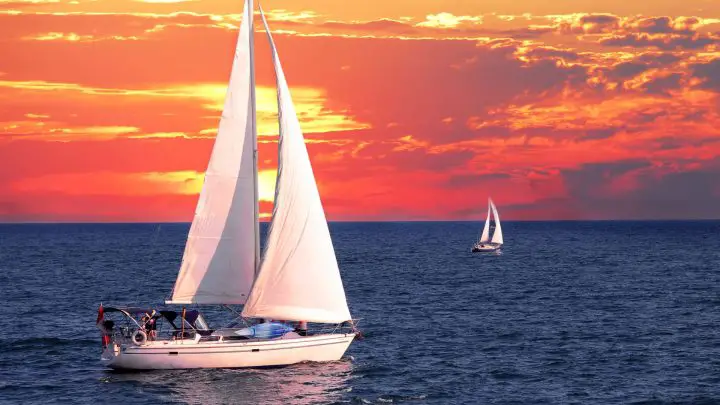
Everyone has a budget when going boat shopping, even if you’re Jeff Bezos or Elon Musk. Establishing how much you can spend on your boat is the biggest factor that will affect your decision, and it’s the backbone for all other decisions.
You must understand just how much boat costs increase as the size of boat increases. Boats are already expensive, and the average cost of owning and buying a liveaboard sailboat varies dramatically. But when the boat gets bigger, it needs bigger hardware, lines, rigging, sails, motors…everything. And bigger means more expensive, so these costs add up fast.
And then there are your storage and boat maintenance costs, all of which are charged per foot. The marina might charge you $15 per foot/per month for a dock slip, and the boatyard will similarly charge you per foot to haul and store the boat. Divers charge per foot for bottom cleaning, as do detailers for annual compounding and waxing of the hull.
When it comes to budgeting, there are two rules of thumb.
- Always pick the smallest boat you can comfortably live on.
- If you have an amount budgeted for your boat purchase, spend half on the boat and save the other half for outfitting and maintenance.
As you’ll see below, boats can be grouped by price and size. When you go up in size, you go up in price—often by a lot.
The size of the boat is a factor of your budget, but also of how big a boat you can handle. Most people believe this means driving it and maneuvering it, which is true to some extent. But a good training captain can teach you what you need to know to drive any size boat in just a few sessions.
No, the size of the boat you can manage refers more to how much maintenance you want to do. The bigger the boat, the more complex and plentiful its systems. There’s more to break on a bigger boat, and more things broken means more time fixing things.
Catamarans compound this by doubling a lot of the systems. Two engines, two saildrives, two hulls to wax, two hulls to bottom paint—you get the idea.
Another factor you should consider early on is getting insurance. Yacht insurance has gotten harder and harder to get in recent years. If you’ve never owned a boat and have no experience, you might be forced to get something small (think an under 30-foot daysailor) to get some experience on before you move up. It’s also difficult because many underwriters won’t write policies for liveaboards.
As a general rule of thumb, most people will find boats under 35 feet too small to live on full-time. Most of these vessels don’t even have standing headroom. There is often only a “wet head,” one where you take showers while sitting on the toilet.
Boats 35 to 40 feet are good for solo travelers or couples who don’t mind living in small quarters. The beds will be small and accessed only from one side, as in a v-berth or a Pullman-style berth. If there is one, the second bunk is likely only for the occasional guest.
You’ll get better accommodations when you move up to 40 to 45 footers. The second bunk may be in its own stateroom. The main suite will have an island-style berth that can be accessed from both sides—a huge upgrade for most couples. The head will likely have a separate, enclosed shower. This size sailing yacht makes a good liveaboard sailboat for most boaters.
Boats bigger than 45 feet are best for bigger families. If you often travel with kids or guests, these are the boats for you. They’re extremely spacious and make boat living easy, but the extra maintenance and cost may not be worth it.
The List — Best Sailboats to Live Aboard
All lists, whether found in internet blogs or international sailing magazines, have issues. There’s no one list to rule them all because there are simply too many different boats out there. And everyone uses their boat differently, so the “best” for you might be a terrible choice for me. Different boats for different folks, so to say.
So, what’s the deal with this list? It’s made from personal experience of having seen a lot of boats out cruising. And it’s a list that tries to put aside the fantasies—Oysters and Gunboats are pretty in magazines, but like Ferraris, not many of us will ever own one. So let’s look at some practical boats that fill each size category.
For every boat on this list, a dozen or more could’ve been included. Use these models to research brands and see which sizes suit your needs.
Boats under 35 feet tend to be best suited for solo travelers or couples comfortable living in small spaces. As always, coastal cruisers in this class have much more space than bluewater boats do. Catamarans in this class are also coastal cruisers—you need more length and volume to get real bluewater performance out of a cat. No matter which type of boat you’re looking at here, storage space on this size of liveaboard boat will be limited.
View this post on Instagram A post shared by Wilderness Of Waves (@wildernessofwaves)
Coastal Cruiser Under 35 — Catalina 34/35
If you want to move aboard, you’re on a budget, and you want the most space you can get, it’s really hard to beat an older Catalina. Starting with the Catalina 30, these beamy boats have a surprising interior volume. They make great first liveaboards.
Bluewater Sailor Under 35 — Panda/Baba 35, Tashiba 36
The famous yacht designer Bob Perry drew these Taiwanese-built boats, all tracing their lineage to the older Tayana 37 . They’re updated slightly and built by different yards, but all full keels with cutaways and built for bluewater cruising. They all have gorgeous teak joinery and are comfortable and forgiving at sea.
Catamaran Under 35 — Gemini 105MC
The Gemini 105M and 105MC were arguably the most popular cat models ever. They’re American-built, with a single diesel engine and a narrow beam that allows them to be parked in a standard boat slip. In the US, this means many more marina choices if that’s how you roll. The boat has centerboards and kick-up rudders, so the board-up draft is a scant 18 inches—gunkholing perfection.
While some Geminis have crossed oceans, they aren’t made for it. They have average (sometimes below-average) build quality and fiberglass work. However, they’re perfect coastal cruisers and capable of heading into The Bahamas.
The Gemini should be on your shortlist if you’re looking for a cheap catamaran .
Runner Up: PDQ 32
Are you looking for a small cat with better build quality? They didn’t make many of them, but the PDQ 32 is what you seek. It’s an attractive small catamaran with a wider beam. It came with twin outboards in wells, but the LRC (long-range cruiser) option had inboard diesels.
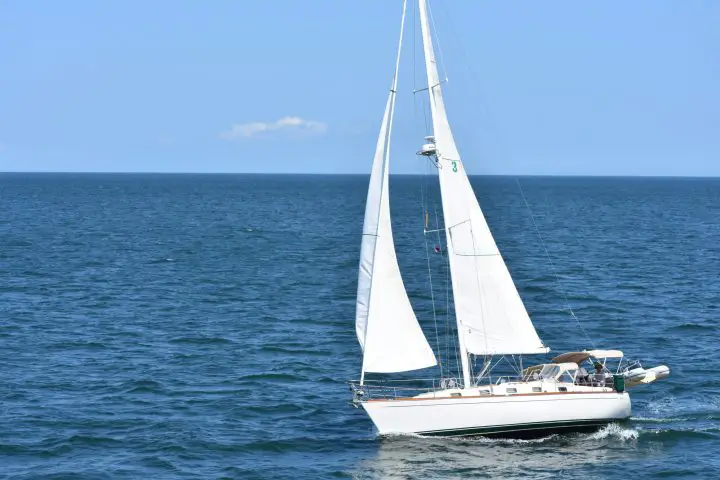
Forty feet is the sweet spot for most cruising couples—big enough to be comfortable and carry enough provisions but small enough that handling and maintenance are manageable. This class of boat has a lot of excellent choices in both coastal cruiser and bluewater boats, making it a good size range to find the perfect affordable liveaboard sailboat.
The catamaran group from 35 to 40 feet has a few very popular choices, but they are right on the edge of being too small for most cruisers. Counterintuitively, these cats are perfect for couples who don’t mind downsizing and traveling lightly. These shorter cats are prone to hobby horsing and don’t provide as comfortable a ride in bluewater as slightly longer cats do.
Coastal Cruiser Under 40 — Islander Freeport 36
The Islander brand is no longer around, but these California-built production boats from the 1970s and 80s were well-built and well-liked. The I32 and I36 were very popular cruising boats designed by Bob Perry. The Freeport 36 is a before-its-time European deck salon with enormous windows. The swing-down swim platform is another bonus for a boat from this era, as are the Pullman-style berth and forepeak-located head (some layouts). If you can find one in good condition, these boats make excellent liveaboards.
Bluewater Sailor Under 40 — Passport 40
Yet another boat from the desk of Bob Perry, the Passport 40, is a sharp-looking aft-cockpit bluewater cruiser from one of the best yards in Taiwan. They feature a long fin keel and skeg-mounted rudder. Everything about this sloop is just right for long-term cruising.
Catamaran Under 40 — Prout 38
The Prout 38 traces its heritage back to the earlier Prout Snowgoose. The boat is still being made, now under the Broadblue brand. It’s a sturdy British-built cat made for serious offshoring. While it lacks some of the open feeling that newer charter boats have, it more than makes up for it with its robust and high-quality build.
Runner Up: Leopard 40 (2005-2009)
This early L40 (don’t get confused with the newer ones built around 2020) was designed by famous multihull designers Morelli and Melvin. It’s got more of the things you might expect from your typical charter cat: a sliding salon door, galley-up layout, and a huge walk-through cockpit.
While this seems a small step up from the size of boats above, prices increase rapidly above the 40-foot mark. At this point, the boat’s gear needs to be bigger and heavier, from all the lines and rigging to each block and winch. Engines are now larger four-cylinder diesels, and there’s much more hull area to clean and paint.
A 45-foot coastal cruiser has enough space to keep a small family happy for short trips or a couple happy for any length of time. These boats usually have island berths in a spacious master bedroom, so no more crawling over each other just to go to the bathroom! Bluewater boats in this class are a little smaller inside, making them just right for most couples doing a long-term cruise.
As far as catamarans go, the 40 to 45-foot range is the perfect sweet spot for most cruising couples. A spacious interior plus excellent seakeeping abilities make these top picks. There are tons of boat choices out there, and most of the best cruising catamarans come from this size group.
View this post on Instagram A post shared by Tara Smith (@minofmine)
Coastal Cruiser Under 45 — Jeanneau Sun Odyssey 42DS
Jeanneau is part of Groupe Beneteau , but their boats often have a more refined finish than Beneteaus. The DS stands for “deck salon.” They feature larger windows that let in more light and have better visibility than a standard cruiser. This is especially welcome if you’re attracted to the living space in a catamaran but need something smaller and more affordable.
The 42DS also has an enormous island berth, plus a huge twin-helm cockpit with lots of space for entertaining.
Bluewater Sailor Under 45 — Hylas 44
The Hylass 44 is regularly picked as one of the best offshore cruising boats. It’s a center cockpit boat designed by German Frers. It has a wonderful layout with tons of living space and a large, usable galley. The aft cabin has a large island berth with an en suite head.
Catamaran Under 45 — Leopard 42/43 (2001-2006)
These early Leopard charter cats are highly sought after on the used market. Like all charter cats, the best finds are the “owners versions” with one hull dedicated to the master stateroom with en suite head and shower. The Leopard 42, which came out in 2002, had a soft canvas cover over the cockpit and was updated to the Leopard 43 with a hardtop.
Above 45 feet is another big price jump. For beginners, these big boats will require some training and experience before you head out on your own.
Related: Best Boat for Beginners
View this post on Instagram A post shared by Leopard 46 "Shanties" (@leopard46shanties)
Coastal Cruiser Under 50 — Beneteau Oceanis 473
This big Beneteau came with either 2, 3, or 4 staterooms. Finding the right layout is as important as finding the right boat. The two-stateroom version has enormous berths and lots of storage, perfect for couples with occasional guests or families of three. Most have the standard keel with less than a six-foot draft, making this fin keel/spade rudder boat a rare find. They were built from 2000 to 2005.
Bluewater Sailor Under 50 — Hallberg Rassy 46/48
Hallberg Rassys are well-regarded boats built in Sweden, mostly designed by German Frers. These are high-end boats of the best quality, so don’t expect to find one available cheaply. They’re gorgeous, however, and make wonderful world cruisers.
Catamaran Under 50 — Leopard 46/Moorings 4600 (2006)
If you want a big catamaran, it’s hard to go wrong with the 2006 Leopard 46. Where modern Lagoon and Leopards have tall profiles with tons of windage, this is one of the newest, largest boats that still have single-level living. It has distinctive hull chines that increase living space without increasing wetted surface and plenty of sail area for good performance. In true Leopard fashion, all lines are led to the helm for easy short-handed cruising despite the boat’s large size.
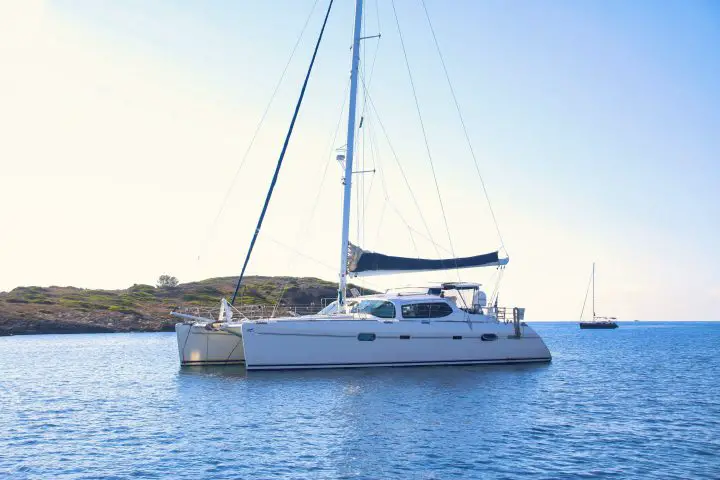
Boats in this class are borderline yachts based on their sheer size. If you were to charter these boats, they’d usually come with a crew. That size means they’re more expensive and more of a handful to manage daily.
Coastal Cruiser Under 60 — Irwin 54
The Irwin brand is long gone, but many examples are available on the used market. They were known especially for their large center cockpit ketches, like this 54-footer. This is a spacious, big water boat that certainly meets the qualifications of most bluewater boats. They can go anywhere, but they may need maintenance and refit given their ages.
Don’t get to lured by the low prices of these boats. You’ll have to lay out some serious cash to get one ready to cruise long-range. But if you aren’t opposed to some hard work and projecting, the Irwin can get you a lot of boat for not much money.
Bluewater Sailor Under 60 — Amel Super Maramu 2000 (53′)
Made famous by the Delos YouTube channel, the Amel is a French-built brand of high-quality bluewater boats. Today, this brand’s new models look like many others—wide sterned, flat-bottomed sloops. But the Maramus that made them famous were unique—ketch rigged and ruggedly built, designed to take a cruising couple anywhere. Electric winches were standard on everything to keep such a large boat easy to operate.
Catamaran Under 60 — Privilege 585
Privilege is the French-made catamaran that you don’t hear enough about. Unlike Lagoon and Fountaine Pajot, these are beefy cruising boats ready to take you anywhere. Their construction and fit-and-finish are first-rate, as is the joinery down below.
Living on a sailboat is an adventure—it’s not for everyone. Finding the right boat is an important part of doing it successfully, but it’s not the only step in preparing for the lifestyle.
You should also consider checking my post on liveaboard catamaran options, to make sure you research thoroughly enough!
What makes a great liveaboard sailboat?
Everyone’s priorities for a liveaboard sailboat are different—a bluewater cruiser looking to sail around the world might pick a very different boat from someone who lives full-time dock life. In general terms, you need to find a boat that is safely capable of taking you where you want to go and has enough living space to be comfortable while doing it.
Sailing catamarans are some of the most popular liveaboard sailboats because their living space is unmatched. Most are also bluewater-capable cruisers that can go pretty much anywhere.
What is the best size sailboat to live on?
The size of the boat you’ll be comfortable on long term is a personal choice that depends on your personality and the number of people you’ll be traveling with. Solo travelers may be content with a sailboat around 30 feet, while most couples are comfortable on something around 40 feet. Forty-five to fifty feet is more realistic if you often have guests or kind on board.
With all of this in mind, however, it’s really important to remember that the costs of buying and maintaining a sailboat increase exponentially with length. Getting the smallest boat you are comfortable living on is always better because that will be easier to manage and keep in the long run.
What are the negatives of living on a sailboat?
People live on their sailboats differently, so it’s difficult to narrow down the biggest negatives. Everyone struggles with the small living space that a boat affords. You’ll have to downsize your possessions to the absolute minimum you need. And getting personal space away from your spouse or family is pretty much impossible on a small boat.
Why are sailboats so expensive?
New boats require a massive investment in time and resources to produce. The nicer the boat, the more time and skill it takes to build, which makes costs soar. Some production companies, like Beneteau, have found ways to reduce production costs and keep the price of new boats more reasonable. But these boats pale compared to other yachts in terms of overall quality.
Older used boats can be found pretty cheaply. In fact, it’s often possible to find free or nearly-free boats that are on their way to the junkyard or dumpster. The key is understanding how much work and money it will take to get these boats ready to go again.
Is it a good idea to live on a sailboat?
Living on a boat is an amazing way to experience seaside living or traveling the world by water. But it’s also a unique, out-of-the-ordinary lifestyle choice that’s not without challenges.
Before you move onto a sailboat, you’ll want to research the topic carefully and talk to some folks who already to it. Many people start with occasional boating, spending a week or more onboard to try it out. With a little experience, it’s easy to see if it’s something you could do for the long term or if it’s best to keep a land house and enjoy the water occasionally.
Can you live comfortably on a sailboat?
Many people live comfortably on sailboats, but a lot depends on the size of the sailboat and your tolerance for living in a small space. Even the largest sailboats can feel cramped, while some folks love the cozy feeling of living on the tiniest boats.
Matt has been boating around Florida for over 25 years in everything from small powerboats to large cruising catamarans. He currently lives aboard a 38-foot Cabo Rico sailboat with his wife Lucy and adventure dog Chelsea. Together, they cruise between winters in The Bahamas and summers in the Chesapeake Bay.
Leave a comment
Your email address will not be published. Required fields are marked *
Save my name, email, and website in this browser for the next time I comment.
13 Best Liveaboard Sailboats (under 30 & 50 ft)
Choosing a boat to live on is a big deal — something you definitely want to get right. There are plenty of options to pick from, which can make the choosing process a bit daunting. So to help you navigate those deep waters (no pun intended), here is an article summarizing the 13 best liveaboard sailboats under 30 and 50 feet.
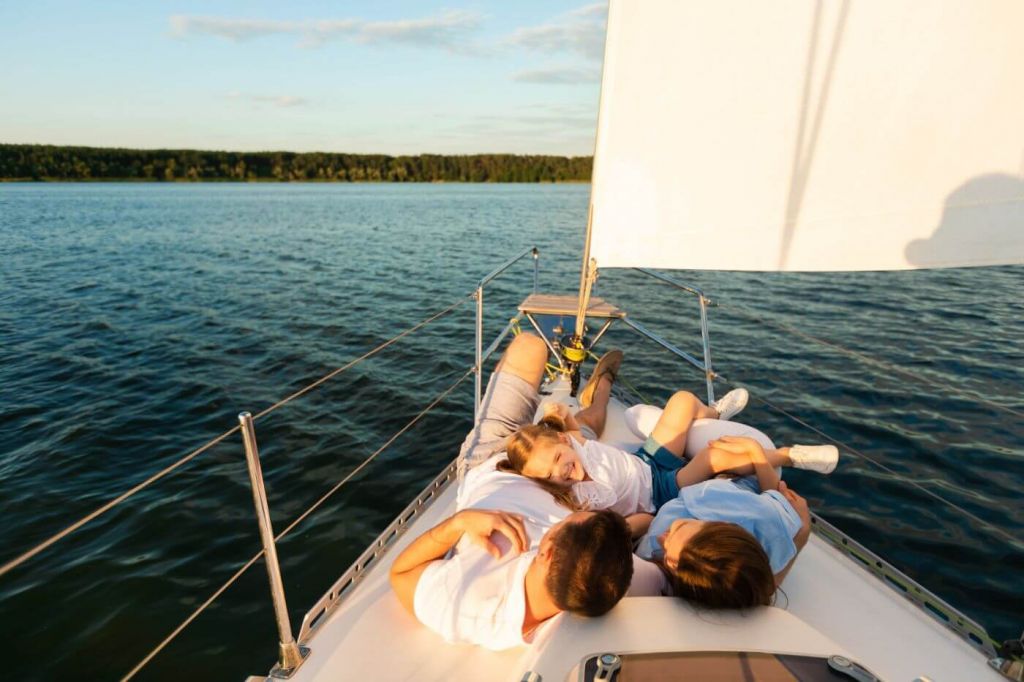
So what are the 13 best liveaboard sailboats?
Catalina 30, pacific seacraft flicka 20, nonsuch ultra 30, aventura 34, island packet 35, peterson 44, prout snowgoose 37, gulfstar 44, beneteau oceanis 50.
Beautiful lineup, isn't it? Let me explain what makes these so special.
Picking the Right One Matters
Picking a liveaboard sailboat belongs among those kinds of decisions that require months, if not years of research and testing.
It is not like choosing a car - those are more or less the same, and although they vary widely in terms of comfort, feeling, and performance, rarely you would encounter one that wouldn't get you from point A to B reasonably.
The same goes for a house or an apartment. Regardless of if you get a 200 square foot condo or a 30,000 square feet mansion, it will most of the time provide a warm shelter with a shower and a kitchen and a bed, fulfilling its basic functions.
But this is only the case because there is extensive infrastructure in place helping cars and houses. A car can only get you from A to B thanks to roads. A house can only have a shower and a kitchen if it is connected to a grid.
But on a boat, you are on your own.
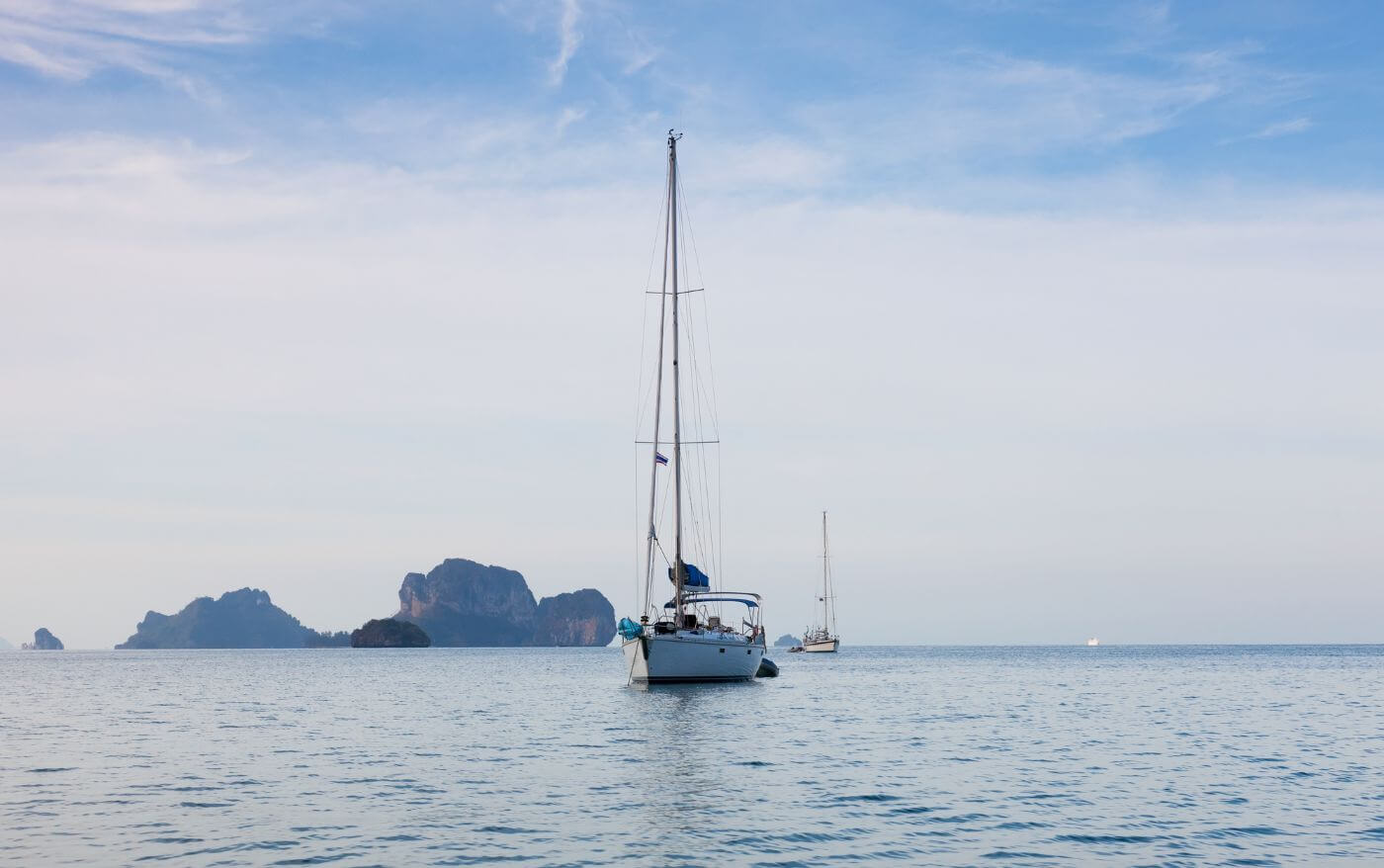
The sea doesn't adjust its waves for your comfort. If something breaks, there is usually not a repair shop nearby. You aren't always connected to water or electricity. And if you don't like what you see around yourself, it's not like you can just leave.
So a liveaboard boat needs to provide what a house does, what a vehicle does, and more, plus it needs to provide this regardless of if you are docked in a marina or in the middle of the Pacific Ocean. That is a lot to ask, especially if we are talking about boats around 30 or 50 feet.
Fortunately, every single boat on this list is an all-star that ticks all the right boxes. Let's see why.
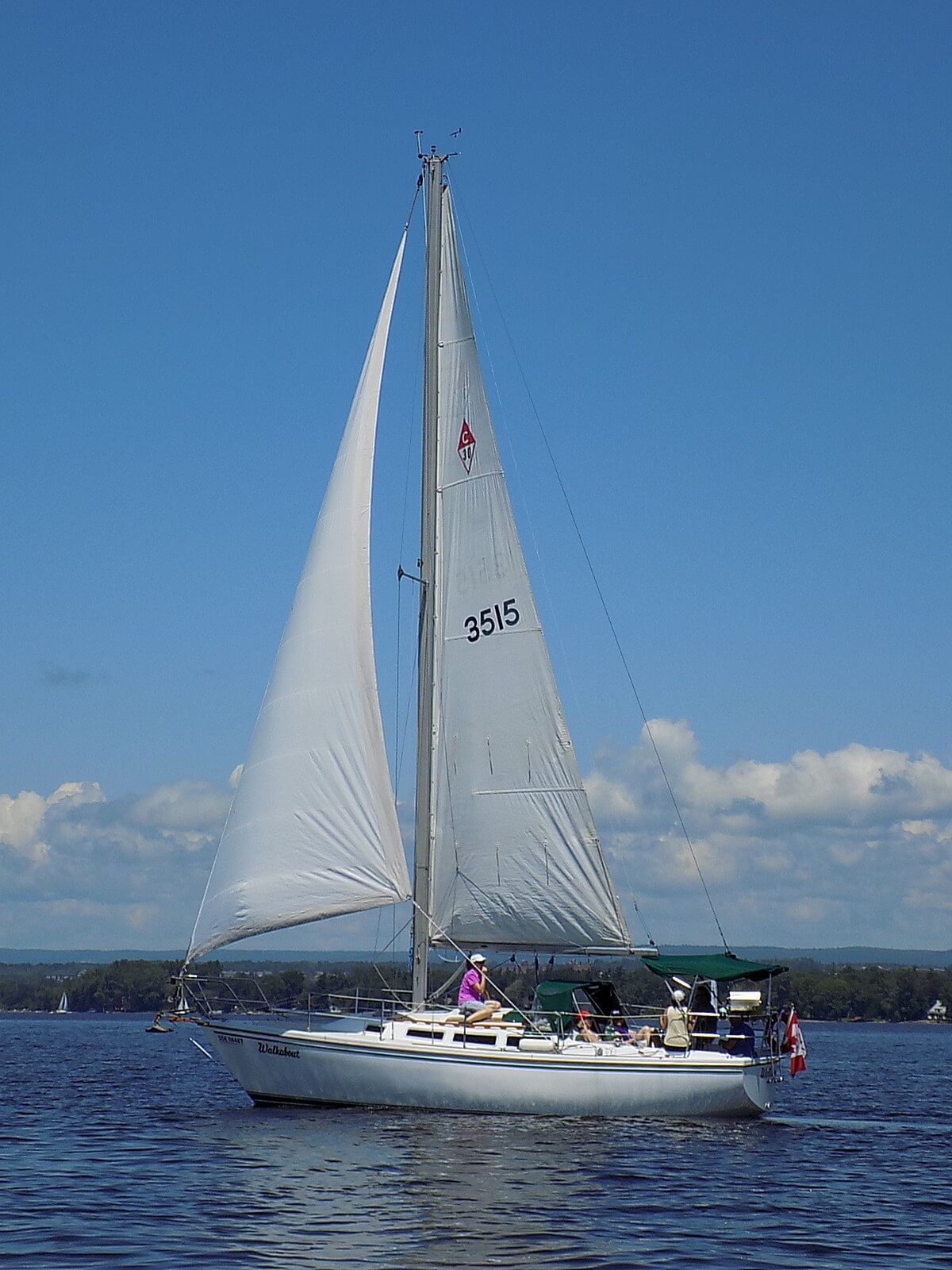
I know, I hear you, it isn't exciting enough as it doesn't perform that well. Sure. But we are talking about a boat that is supposed to be a house too. So why is it on the list?
This boat has been in production since 1975, which means that it has been extraordinarily well-refined according to the suggestions of thousands of owners. And this manufacturer is known for listening to the sailors' feedback. It is a very popular model, so finding spare parts for it will always be easy. Its famous well thought through the salon, and cabin layout is generous and spacious, so Catalinas are comfortable boats to live on. Plus, the boat has quite a wide beam, great ballast/displacement ratio as well as low sail area/displacement ratio, making it a stiff boat under sail, which adds to stability and comfort.
Good condition MkIII Catalinas can be found for about $35,000, but given the volume of these on the market, you can find a usable one even for around $15,000.
This one is a hero. I'd be hesitant to call such a small boat a comfortable liveaboard if it wasn't for this model. For its size, the interior is very spacious. It is also made for comfort since it seems to be inspired by the aforementioned Catalina 30. In fact, after reading some reviews, I am confident in saying that you will not find a significantly more comfortable 27 footer out there.
It also has a talent very uncommon for liveaboard boats - you can put it on a trailer, which can make your life easier when it comes to certain trips. But most importantly, it is a beauty. Just look at it.
Pricing this boat is a tricky task. You can buy nearly new ones (2015) for around $140,000, but even for $50,000, you can stumble upon models from both the 80s and the 2000s. This means the condition is a big factor, and you gotta inspect your choice well. The good news is that whatever your price in that range, you will find a boat for that money. The bad news is that the cheaper you go, the more effort will the potential repairs take.
I thought the Nor'Sea 27 is gonna be it, but let's push the size limit even more with the 20 foot Flicka, this tiny, towable, but seaworthy beast that accomplished several circumnavigations. Upon entering, you will be amazed at how spacious and equipped with amenities the interior is. Its designer lived on this boat with his partner (who too was a naval architect) for years and cruised all around the world - and what a proof of confidence in his own design that is.
Truth be told, there is a lack of deck space, but underneath it has the comfort and size of a boat a few meters larger, a space you can comfortably live in. Due to its size, it is easy to operate, tow, and sails better than what you would expect from a boat this length.
This boat is incredibly charming, and so its owners rarely sell it. In fact, it has amassed quite a following since it was designed into existence. So expect to spend quite some time searching for one for sale. Once you do find one, it will cost you around $30,000 - $40,000.
This one's a weird one. But because of it, a very spacious one. It is structured as a catboat, that is, with the mast being all the way on the front of the boat, which makes for impressive space below the deck. It has all the necessary amenities, including a shower, so for the liveaboard lifestyle, this boat definitely deserves to make this list.
The single sail catboat design also means it is easy to handle single-handed, which makes for great solitary passages.
Expect to pay around $40,000 to $60,000 for this one.
Though I am trying to keep this list in lower price ranges, I have to put this one in. If you don't mind the price tag of around $170,000, this boat is marketed as the currently cheapest liveaboard catamaran. As previously mentioned, cats offer the most in terms of space, and this model is a brand new one. Thus when it comes to service troubles and costs, you wouldn't pay much. The look is modern, relatively minimalistic and sleek, so for those of you who would like to give the liveaboard lifestyle a go but get cold feet upon seeing boats from the 80s, this is a way to make sure things remain stylish.
The modernity, space, and attention to practicality when it comes to using this as your home, make this a great entry-level liveaboard choice.
Again, this is no performance vehicle. Rather it focuses on the usual cruiser aspects - space, stability, sturdiness, and convenience, which makes it an ideal candidate for your choice when looking for a new floating home. Aside from the spacious interior, this boat also has an unusually large cockpit, great for those lunches on the deck.
As if the designers knew this might be used by the liveaboard people, this boat is easy to handle, which means even under sail, you won't have issues focusing on what you came for in the first place - sea living.
This boat can be found on the market for around $75,000 - $100,000.
The great thing about the Hunter 33 is that it was designed as more of a house than a sailboat. The attention to accommodation details is great here; there is plenty of space for sleeping the owners as well as the occasional visitors, it has a fantastic headroom throughout the boat and one of the most spacious and comfortable dining spaces seen on boats this size.
Food preparation and consumption was probably high on the priority list of the makers; the kitchen has an L shape, which adds to the convenience.
The price spread on these is quite large, with the bottom around $55,000 for the 2004 models and the top around $95,000 for the 2013 models.
This one is for those who don't mind sacrificing luxury for space. If in the middle of the ocean, it makes sense that one would want as much of usable space as possible, so if you are okay with the simplicity that will inevitably come with a system like this, you have found your match.
An undeniable advantage of such a design approach is that the storage space is maximized. Long passages with the need for plenty of room for equipment and provisions won't be a problem here. The simplicity of this boat is not just in terms of design, but even the electrics and plumbing. Thus if something breaks, you will have an easier time fixing it.
This being an older model, you can get your hands on one for around $30,000.
Since we are mostly looking at cheaper boats here, most of them aren't new - in fact, they likely have quite a few years behind them. The build quality is thus important. You want to go for builds that will last. Peterson is known for this, so it's gotta be on the list. As far as this list goes, it is quite a large boat. Moreover, it is one that has been built with spaciousness in mind, both when it comes to living spaces and storage.
A neat thing about this boat is its attention to performance. It isn't a racer; rather, it fits in the performance cruiser category, but they haven't made too many speed-related compromises here.
Peterson 44 can usually be found for $80,000 - $100,000.
There needs to be a catamaran on this list - they are, by definition, more spacious than monohulls, providing a large living area, which is, of course, an attractive characteristic for a liveaboard boat. Especially if they have a solid bridge deck, creating yet more square feet of usable space, which Snowgoose has. Unfortunately, they tend to be costly. While it is easy to recommend a bunch of half a million dollar cats, to make this list more within reach of the average sailor, I've found this beauty that you can get for around $100,000.
Aside from the extra space, this model is a true bluewater cruiser, meaning you won't be limited by its abilities when planning your journeys.
Those of you who had the pleasure of sailing this boat know why it needs to be here. It was built for a liveaboard lifestyle. Its wide body makes for one spacious interior which is well ventilated, (a very important aspect) with a beautiful galley and it has a large aft cabin with a huge bed. It was made with comfort, practicality, and convenience in mind.
Not to sound like a salesman, but believe me when I say this boat is a genuine pleasure to be on. If you want the homey feeling, you don't get much closer than this in this size range.
Expect to pay around $80,000 - $100,000 for this one, though some digging around and 'fixing her up' can knock this number down significantly.
This is another easy choice, space being the reason. Not only does it have an extra-large main cabin and salon with a kitchen, many small Parisian apartments could envy, but it is also very generous in terms of storage space. Stocking up for longer crossings will be a pleasure on this one.
Also, it was built as a racer-cruiser, so you won't be making many compromises in terms of performance, as is often the case with comfortable boats.
All of this comes for a price, though. You might be able to find one for around $100,000 if you put some time into your search and won't mind a bit of travel to see it, but otherwise, the average price is around $130,000.
Let's end this list by stretching the ceiling too with this fifty-footer. It was designed as a holiday cruiser, and it is a popular choice among charter companies. The designers know that there are places in Europe where it is very easy to get a sailing license, so many inexperienced people who don't want to give up the comforts of their home end up on these boats. Oceanis 50 is thus comfortable, spacious, easy to sail, and the attention to accommodation details, amenities, and practicality, is very high.
As such, it is designed to house whole families, so if you live there as a couple, you will have a floating house for yourself, and if kids come, no need to buy a new boat. Even on the deck, this boat is designed for pleasure cruises, so as far as that goes, you will be taken care of. As far as their seaworthiness goes, some consider Beneteau an entry-level holiday brand, and some models are indeed more designed for coastal hopping than large crossings. But that can be fixed with some proper fitting.
If you fancy a new one, you will find yourself paying above the $500,000 mark, but older models start a bit above $100,000. Which is something a person who just sold all their possessions to escape to the sea is more likely to have. Just be a bit careful with boats sold by charter companies. Their previous owners serviced them regularly, but you can be sure the hundreds of sailors that touched the helm weren't necessarily skilled or kind to them.
So there you have it. $15,000 - $50,0000 range, 20 - 50-foot sizes, from cozy towable boats to large sailing houses. A range anybody can choose from to pursue the liveaboard dream. Nothing is stopping you now, so hit the yachtworld.com website and start browsing.
Know though that if you really want to take advantage of the boat market, you might have to travel quite a bit. If you are an American, the strong dollar will make it enticing to look for a boat in European countries without the EUR currency. Or you might find plenty of cheap models in Turkey, for instance. It requires more effort, but in return, it might save you tens of thousands of dollars.
Fair winds!
Leave a comment

13 Best Liveaboard Sailboats (under 30 & 50 ft)
Living aboard a sailboat offers a unique blend of freedom, adventure, and simplicity. Whether you’re downsizing for a minimalist lifestyle or seeking full-time ocean exploration, choosing the right liveaboard sailboat is essential. Here, we’ll explore the best sailboats under 30 feet and 50 feet, balancing comfort, price, and performance.
Best Liveaboard Sailboats Under 30 Feet
Smaller boats offer simplicity and ease of handling, making them ideal for solo sailors or couples. These options are more affordable, and despite their size, they provide everything necessary for comfortable living aboard.
1. Catalina 27
- Length: 27 ft
- Beam: 8.83 ft
- Draft: 4 ft (fin keel)
- Price: $7,000 – $15,000 (used)
- Specs: The Catalina 27 is one of the most popular small sailboats for living aboard. Its spacious cabin can comfortably accommodate two people with amenities like a galley, head, and sufficient storage. It’s lightweight and easy to sail, perfect for coastal cruising.
2. Albin Vega 27
- Length: 27.1 ft
- Draft: 4 ft
- Price: $10,000 – $20,000 (used)
- Specs: Renowned for durability and versatility, the Albin Vega is a Swedish classic. Despite its small size, it’s known for taking sailors across oceans, making it ideal for those dreaming of long-distance cruising on a budget. It features a well-laid-out interior with enough space for two people to live comfortably.
3. Nor’Sea 27
- Draft: 3.5 ft
- Price: $35,000 – $70,000 (new and used)
- Specs: Designed for bluewater cruising, the Nor’Sea 27 is a rugged boat built for open ocean adventures. It’s compact but offers impressive living space, thanks to a raised deck and a deep cockpit. Known for its stability, this boat is perfect for solo sailors or couples seeking adventure in a manageable size.
4. Pacific Seacraft 25
- Length: 25 ft
- Price: $15,000 – $30,000 (used)
- Specs: Often considered a pocket cruiser, the Pacific Seacraft 25 is a solid choice for anyone wanting a small, yet seaworthy boat for liveaboard life. Its double-ended design and heavy displacement make it stable in rough waters. Inside, it offers a cozy, well-thought-out space with a compact galley and sleeping accommodations for two.
5. Westerly Centaur
- Length: 26 ft
- Beam: 8.5 ft
- Draft: 3 ft
- Price: $7,000 – $20,000 (used)
- Specs: A British classic, the Westerly Centaur is a bilge keel boat, which means it can sit upright when grounded, making it excellent for tidal areas. It has a spacious interior for a boat of its size, accommodating up to five people. The Centaur is ideal for coastal cruising and exploring shallow waters.
Best Liveaboard Sailboats Under 50 Feet
For those seeking more space, luxury, and offshore capabilities, boats in the 40-50 ft range are the perfect choice. These sailboats offer all the comforts of home, with larger cabins, more storage, and the ability to take on long-distance cruising with ease.
6. Beneteau Oceanis 46.1
- Length: 47.9 ft
- Beam: 15.75 ft
- Draft: 7.1 ft
- Price: $350,000 – $450,000 (new)
- Specs: The Oceanis 46.1 is a modern, spacious cruiser designed for long-term living aboard. Its wide beam allows for expansive interior spaces, including a large salon, full-sized galley, and multiple cabins. It’s designed for comfortable, long-distance cruising, with excellent storage and performance under sail.
7. Jeanneau Sun Odyssey 490
- Length: 47.3 ft
- Beam: 14.75 ft
- Draft: 7.3 ft
- Price: $450,000 – $550,000 (new)
- Specs: The Sun Odyssey 490 is a cutting-edge design with luxurious living quarters and a focus on ease of movement. The interior features a large saloon, spacious galley, and generous cabins, making it perfect for families or those who entertain aboard. Its performance and comfort make it a top choice for liveaboard sailors who also seek adventure.
8. Lagoon 450 (Catamaran)
- Length: 45 ft
- Beam: 25.75 ft
- Draft: 4.2 ft
- Price: $500,000 – $700,000 (new)
- Specs: For those looking for maximum space and stability, the Lagoon 450 catamaran offers plenty of room with its wide beam and dual hull design. It’s like a floating apartment, with expansive living areas, a large galley, and multiple cabins. Perfect for families or those who desire more space, this boat is made for long-term comfort at sea.
9. Hallberg-Rassy 48 Mk II
- Length: 49.25 ft
- Draft: 7 ft
- Price: $600,000 – $900,000 (new)
- Specs: Known for its solid construction and bluewater capabilities, the Hallberg-Rassy 48 Mk II is a premium yacht. It offers luxurious living spaces and top-notch safety features, making it ideal for serious liveaboard sailors planning to cross oceans. The interior is elegantly appointed, with plenty of room for both entertaining and storage.
10. Tartan 4700
- Length: 47 ft
- Beam: 14 ft
- Draft: 6.5 ft
- Price: $700,000 – $1,000,000 (new)
- Specs: The Tartan 4700 combines classic design with modern features, offering a beautiful balance of performance and comfort. The interior includes large living spaces, a gourmet galley, and multiple private cabins. Tartan is known for their craftsmanship, and this boat is perfect for liveaboard sailors who value both luxury and sailing performance.
11. Hylas 49
- Length: 49 ft
- Beam: 14.5 ft
- Draft: 6 ft
- Price: $400,000 – $600,000 (used)
- Specs: The Hylas 49 is a well-respected offshore cruiser with a focus on performance and comfort. It has a spacious, beautifully crafted interior, including a large saloon, dedicated navigation station, and roomy cabins. It’s perfect for those looking for a high-quality boat capable of crossing oceans or living aboard in comfort.
12. Bavaria Cruiser 46
- Length: 46.8 ft
- Beam: 14.25 ft
- Draft: 6.75 ft
- Specs: The Bavaria Cruiser 46 offers a perfect balance between luxury and affordability. With a modern, spacious interior and ample storage, it’s great for full-time liveaboard life. Its sailing performance is excellent, making it a favorite for both coastal cruising and longer offshore voyages.
13. Island Packet 465
- Length: 47.8 ft
- Beam: 14.33 ft
- Draft: 5 ft
- Price: $450,000 – $600,000 (used)
- Specs: The Island Packet 465 is designed for safety and comfort on long voyages. It has a traditional design with a heavy displacement that provides a stable ride. The interior is spacious, with a large saloon, galley, and multiple staterooms, making it ideal for liveaboards who prioritize comfort and long-distance cruising.
Choosing the best liveaboard sailboat depends on your personal preferences, sailing style, and budget. For those seeking smaller, more manageable boats, options like the Catalina 27 and Nor’Sea 27 offer simplicity and affordability. If space and luxury are priorities, the Beneteau Oceanis 46.1 or Lagoon 450 provide plenty of comfort for long-term living aboard.
Each of these boats offers unique strengths, so weigh your needs carefully to find the one that best fits your liveaboard lifestyle.
Happy Boating!
Share 13 Best Liveaboard Sailboats (under 30 & 50 ft) with your friends and leave a comment below with your thoughts.
Read 13 Best Liveaboard Catamarans (For All Budgets) until we meet in the next article.
Leave a Comment Cancel reply
Save my name, email, and website in this browser for the next time I comment.
10 Best Sailboats To Live In

Living aboard a sailboat is an exciting lifestyle choice, but there are lots of considerations you’ll need to make.
First and foremost, you have to pick a boat to live in. Unless you plan on sleeping under a canvas tarp, it’s essential to find a sailboat with a proper cabin.
Cabin sailboats became common in the United States during the early 20th century, but size and amenities vary widely between boats.
For example, early wooden sailboats generally featured very sparse accommodations below, typically consisting of a pipe berth, oil lamps, a coal-fired stove and a bucket privy—typically without standing headroom.
Fortunately, the majority of cabin sailboats came with a lot more than a bucket to wash with.
In this article, we’ll go over some of the most important considerations to make when choosing a sailboat to live on . After, we’ll give a top-ten list of the best used liveaboard sailboats you can buy today.
Table of contents
Why Live Aboard a Sailboat?
Thousands of people choose to live aboard their sailboats. It’s an alternative lifestyle with a host of benefits for those willing to deal with the added challenges.
Liveaboards can move their entire house on the water, and it’s typically cheaper to live on a boat than in a traditional house.
This is especially true in major waterfront cities, where rent in the same area as the marina can be several times more expensive.
Some people love the marina lifestyle, and others travel the world. All-in-all, living aboard a sailboat can be a rewarding, enriching, and financially-freeing lifestyle choice.
What to Consider when Buying a Liveaboard Sailboat
The most important thing to consider when buying a liveaboard sailboat is what level of accommodation you need.
Some people aren’t bothered by limited amenities; in fact, many traditional sailors prefer a stripped-down and basic sailboat interior. However, many others appreciate useful features such as electric toilets and a full galley.
You can find virtually every creature comfort on board a modern sailboat, so it’s up to you to decide what level of convenience you expect.
For most people, a standard cruising sailboat interior from after 1970 will suffice, as these typically include a usable galley, shower, head, and ventilation.
Offshore VS Coastal Cruising Accommodations
Sailboat interior design is dependent on certain criteria, such as the sailboat’s intended use. Long-distance cruising sailboats have cabins arranged to suit such a journey.
Long-distance sailboats usually remove any unnecessary furniture or extras down below to increase storage, and sleeping options are altered to ensure easy access, which allows the crew to regain control of the boat in a pinch.
Coastal cruisers tend to feature a more luxurious layout, with larger sofas and more complex interior features. Additionally, storage space is generally reduced to allow for the inclusion of other amenities.
Whichever style you choose should reflect both how you plan to use your boat and what level of comfort you need.
What Makes A Great Liveaboard Sailboat?
For this article, we’ve outlined a few requirements which we believe identify an excellent liveaboard sailboat :
- Standing headroom (at least 5’10”)
While many people live aboard boats without standing headroom, it’s still a nice feature to have. Months or years spent crawling or crouching can wreak havoc on your back and body, so standing headroom is a necessity in this list.
- 120V AC availability
Electricity is a definite requirement for our liveaboard list. Boats without 120V AC outlets present major challenges to liveaboards, as there’s no way to charge most computers or cell phones. Some boats feature a 12V outlet, but full-time liveaboard boats should have standard house connections for electricity.
- Galley facilities
Unless you plan on eating out every day, a galley is a must for our list. We define an adequate galley as a facility with a sink, ice box or refrigerator, and a stove. An oven is an added bonus, but one can usually be added along with a new stove.
- Electric lighting
Electric lighting is a matter of both safety and convenience aboard boats. There’s nothing wrong with kerosene lamps; many sailors adorn their boats with them. However, a long-term liveaboard boat should feature safe and reliable electric lighting.
- Toilet with plumbing
Sanitation facilities are vital on board a sailboat, especially if you live on it. Improper human waste storage and disposal will spread awful diseases. Plus, nobody wants to live on a stinky boat or use a porta-potty all year long. We required each of our ten boats to have built-in and properly outfitted toilets, plus safe storage tanks for pumping out later.
Bathing facilities are also a must on most liveaboard sailboats. However, many liveaboards opt not to use their on-board showers in favor of marina or gym facilities. That being said, it is very convenient to have a shower on your boat. Keep in mind, some boat showers drain directly into the bilge. If you use your onboard shower, be sure to keep the bilge pump in working order and remember that anything you put in the drain ends up below your floor.
- Separate seating spaces
We think a liveaboard sailboat should have extra sitting spaces on board, apart from the main bed. A place for sitting, eating, working, and navigating is essential when living aboard long-term, and the added convenience of a separate space will make day-to-day activities much more enjoyable.
- Ventilation
Last but not least, we believe ventilation is essential for any liveaboard sailboat. This is the simplest of requirements, as a passive solar roof vent or opening porthole should be sufficient. In short, there should be a way to let fresh air in without opening a main hatch.
Top 10 Liveaboard Sailboats
Here’s a list of the top ten liveaboard sailboats that you can purchase used today.
These are in no particular order, but each boat meets or exceeds the requirements of a great liveaboard sailboat.
Remember, the features listed for each of these boats could vary based on age or trim, so be sure to check back to this list when inspecting a boat.
Without further ado, here’s ten of the greatest liveaboard sailboats ever produced.
1. Catalina 30
{{boat-info="/boats/catalina-30"}}
The Catalina 30 is one of the most common production cruising sailboats ever.
Thousands of these reliable and robust fiberglass boats still sail, despite the fact that they first entered the market in 1972.
This 30-foot boat features a modern and spacious interior, with all the accommodations you’d expect on a boat its size.
Most models feature a large and useful galley, along with running water supplied by electric pumps.
The Catalina 30 also featured a ‘suite’ layout, with a master bedroom V-Berth closed off to the rest of the cabin by a door.
An enclosed shower and head make it a pleasant boat to live on.
The layout of the Catalina 30 also featured a dinette, which serves as an excellent chart table or workspace as well.
2. Islander 36
{{boat-info="/boats/islander-36"}}
The Islander 36 is a well-rounded liveaboard sailboat which also has impressive cruising capabilities.
While manufacturing ceased in the 1980s, the I-36 was the company’s best-selling model with nearly a thousand built.
Islander boats are known for some well-adorned cabins, and many featured elegant wooden interior trim.
Like the Catalina 30, the Islander 36 includes an enclosed head with a shower and flush toilet.
The interior layout of the I-36 is spacious and well-designed, featuring a long port and starboard settee which folds out into a double-berth for sleeping.
An enclosed shower and spacious master berth make it a very well-rounded option for cruising and living aboard.
3. Contessa 32
{{boat-info="/boats/contessa-32"}}
Contessa Yachts produced their venerable 32-foot cruising and racing sailboat from 1970 until 1990, but custom boatbuilders still manufacture the yacht today.
It’s well-known for cruising capabilities, but it has a lot to offer as a liveaboard as well.
The traditional cabin is thoughtfully designed, featuring a fold-up table in the center of the cabin floor.
The spatially conscious design of the Contessa 32 makes it an excellent option for the no-frills and organized sailor.
This vessel features a separate master bedroom, along with a head and shower in the hallway between the compartments.
4. Pearson 34
{{boat-info="/boats/pearson-34"}}
Pearson produced their excellent 34-foot sailboat during the 1980s. This medium-sized cruising yacht features an extremely spacious interior with plenty of floor space to move around.
The layout is complex, but not overwhelming. The galley nook is functional and features convenient overhead storage for utensils giving it a ‘home-y’ feeling.
The head is enclosed and spacious, including a bathroom sink and mirror.
The separate master bedroom is also enclosed with ample clothing storage throughout.
Out of all the boats listed so far, the Pearson 34 should feel most like a traditional living space to most people.
If the Pearson 34 seems a little too compact, be sure to read on and check out the next two boats on the list.
5. Nordic 40
{{boat-info="/boats/nordic-40"}}
So far the largest boat on our list, the Nordic 40 is a super-capable offshore cruiser with excellent liveaboard facilities.
This relatively rare boat features an extremely spacious interior, which is more than ample for a couple to live comfortably.
Standing headroom throughout, a spacious master bedroom, along with a nearly full galley allows for superbly comfortable living in any climate or region.
The extra storage aboard makes remote living possible, so owners can anchor out for weeks or months at a time with enough provisions to last.
While this boat isn’t very common, it’s still worth keeping an eye out for it while searching for a liveaboard sailboat .
6. Peterson 44
{{boat-info="/boats/kelly-peterson-44"}}
The Peterson 44 is what’s known as a ‘center-cockpit cruiser,’ featuring a split-cabin both fore and aft.
This spacious interior layout maximizes living space without decreasing sailing capabilities.
The boat features a master bedroom and bathroom, along with another cabin, berth, and head behind the cockpit.
In addition to two bathrooms, it features a full galley, booth dinette, and settee.
All these extras combined with excellent storage make it an excellent liveaboard option.
Pearson is well-renowned for building excellent boats, and their interior quality is above average.
7. Nor’Sea 27
{{boat-info="/boats/norsea-27"}}
The Nor’Sea 27 is a classic compact sailboat, which is ideal for minimalist or single people living aboard.
The interior is surprisingly spacious for its size, featuring all the amenities you’d expect on a larger boat.
This beautiful little boat likely mimics the comfort of a Catalina 30, and should cost less in slip fees.
The interior features a toilet, shower, and galley.
The forward berth converts into a dinette but features two other bunks underneath the cockpit.
Production of the Nor’Sea 27 began in 1976, and it’s still produced today.
And the best part—you can legally tow it on a trailer. It’s arguably the ultimate compact cruiser/liveaboard available today.
{{boat-info="/boats/cal-34"}}
The Cal 34 is very typical of mid-range sailboats of the 1970s. Produced between 1968 and 1975, this basic but comfortable yacht has a lot of potential as a liveaboard.
The interior is simple and spacious, without much luxury or adorning. However, less features make for less maintnence, and everything you’d need is available in the Cal 34.
A master bedroom, shower, and toilet are all standard, along with a well-arranged galley and comfortable sitting area.
The boat features ample storage for clothes, food, and gear.
All mechanical, electrical, and plumbing systems aboard are easy to maintain, plus the cabin is well-designed.
9. Catalina 38
{{boat-info="/boats/catalina-38"}}
Another classic Catalina sailboat makes the list, with a well-thought-out interior that’s spacious enough for a couple to live comfortably.
Catalina produced their 38-foot sloop between 1977 and 1990, and it came standard with many excellent liveaboard features such as electrical outlets throughout the cabin.
Also, the head is spacious and includes a sink, which is always very convenient.
With plenty of places to sleep, there’s no need to fold away the galley table to get some rest.
The Catalina 38 is another fantastic mid-sized sailboat for living aboard, especially if you aren’t quite comfortable inside a Catalina 30.
10. Hunter 33
{{boat-info="/boats/hunter-33"}}
The last boat on our list is also one of the longest-lived in its category. Hunter produced their 33-foot sailboat starting in 1977, and it’s still in production today.
This handy mid-sized boat features excellent interior accommodations, with plenty of sitting and sleeping areas to choose from.
In addition to a full dinette, it features a toilet and shower aft away from the master bedroom. Such an arrangement is a great option for sailors, as it allows the use of the head without moving too far away from the controls.
Standing headroom throughout the long cabin makes for a very comfortable long-term living arrangement.
The galley has plenty of storage space and the L-shaped layout allows for easy and efficient use.
At the end of the day, you’ll get to choose the liveaboard sailboat that works best for you. Check out some of the boats we mentioned and get an idea of what they offer.
Use this list to help identify features that you need, and perhaps avoid features that you don’t want.
When it comes to living aboard, there’s a lot more to consider than just your boat. As long as the boat you choose is in good condition, you’ll likely end up falling in love with it.
Either way, consider these top-ten liveaboard sailboats when you’re on the hunt for your boat.
Related Articles
Best Liveaboard Catamaran Sailboats
5 Best Liveaboard Bluewater Sailboats
Living On A Sailboat - Pros & Cons
How To Live on a Sailboat
Daniel Wade
I've personally had thousands of questions about sailing and sailboats over the years. As I learn and experience sailing, and the community, I share the answers that work and make sense to me, here on Life of Sailing.
by this author
Best Sailboats
Most Recent

What Does "Sailing By The Lee" Mean?
October 3, 2023

The Best Sailing Schools And Programs: Reviews & Ratings
September 26, 2023
Important Legal Info
Lifeofsailing.com is a participant in the Amazon Services LLC Associates Program, an affiliate advertising program designed to provide a means for sites to earn advertising fees by advertising and linking to Amazon. This site also participates in other affiliate programs and is compensated for referring traffic and business to these companies.
Similar Posts

Best Small Sailboats With Standing Headroom
December 28, 2023

Best Bluewater Sailboats Under $50K


How To Choose The Right Sailing Instructor
August 16, 2023
Popular Posts

Can a Novice Sail Around the World?
Elizabeth O'Malley
June 15, 2022

4 Best Electric Outboard Motors

How Long Did It Take The Vikings To Sail To England?

10 Best Sailboat Brands (And Why)
December 20, 2023

7 Best Places To Liveaboard A Sailboat

10 of the Best Bluewater Sailboats Under 40 Feet
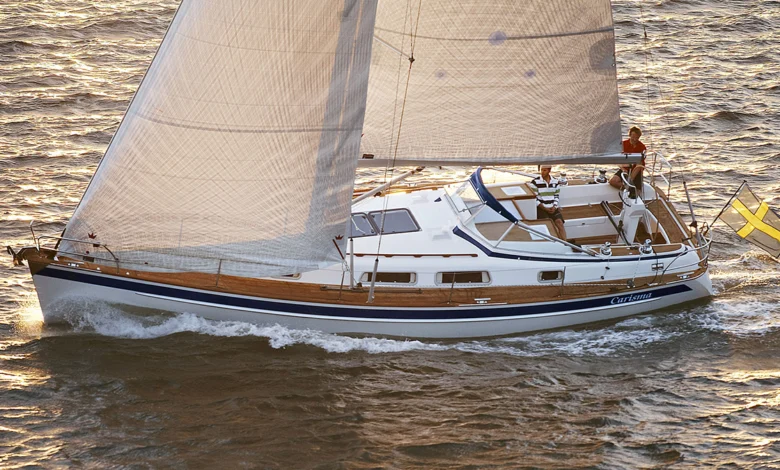
Navigating the open seas requires a model that combines performance, safety, and comfort. For sailors seeking adventure beyond the horizon, choosing the right bluewater sailboa t is paramount. In this article, we’ll delve into the technical specifications and features of 10 of the best bluewater sailboats, both monohulls and catamarans, all under 40 feet in length.
Hallberg-Rassy 372
Length: 37’6″.
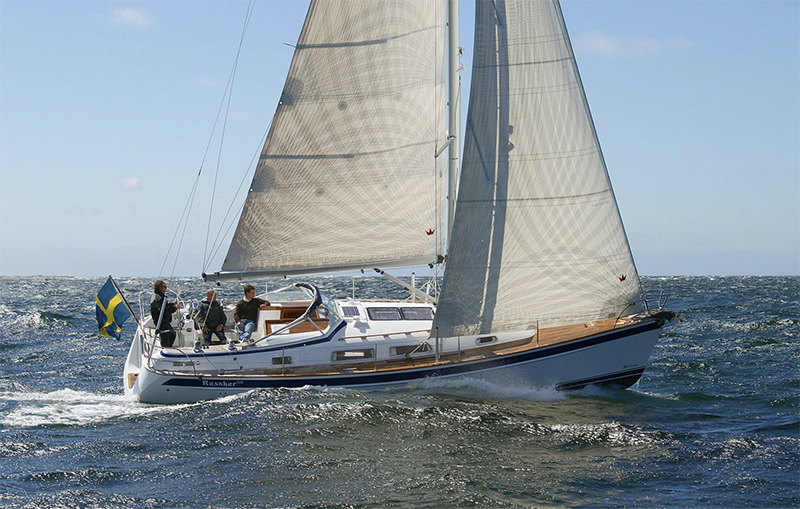
The Hallberg-Rassy 372 was built in 120 units and is optimized for comfortable and fast family cruising. She will take you anywhere, anytime. Compared to the Hallberg-Rassy 37, the 372 is only a few centimetres longer, is 5 cm wider and has a fuller transom. The canoe body is slightly shallower, the waterline longer and the keel slightly deeper and lighter. The aft and mid sections of the hull are flatter and the bow section sharper. The sheer line is more pronounced. All this gives both improved sailing performance and more interior space. The modern sailplan is easy to handle. The yacht breathes graceful elegance.
Hallberg-Rassy may be best known for its centre cockpit boats, but over 5 900 of so far 9 700 built Hallberg-Rassys have an aft cockpit. The aft cockpit 372 is in every aspect an all-new Frers design and is not based on the centre cockpit Hallberg-Rassy 37.
The boat features a moderate draft, allowing it to navigate a variety of water depths with ease. The combination of a long waterline and a well-balanced sail plan contributes to its impressive performance under sail. The Hallberg-Rassy 372’s deck layout is thoughtfully designed for single-handed sailing, with well-positioned winches and control lines.
Stepping below deck, the Hallberg-Rassy 372 welcomes sailors into a spacious and well-appointed interior. The layout is designed with extended bluewater cruising in mind, offering comfort and practicality. The main saloon features a U-shaped settee around a large dining table, providing a cozy space for meals and relaxation.
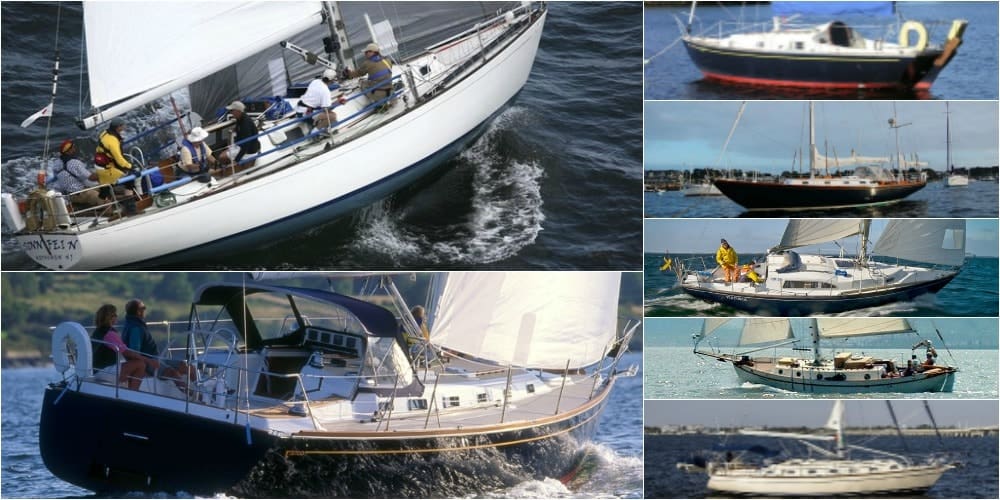
The galley is equipped with all the amenities needed for preparing meals at sea, including a stove, oven, refrigerator, and ample storage space. The cabins are designed for comfort, with generous berths and storage solutions that make long journeys a pleasure rather than a challenge.
Outremer 4X
Length: 40′.
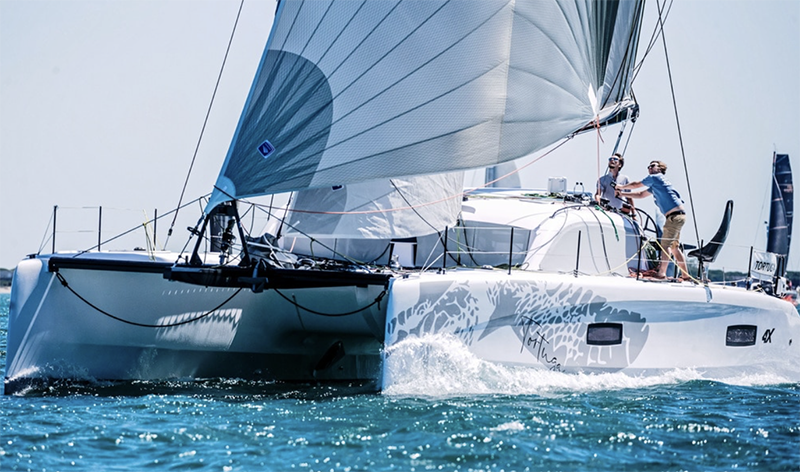
This catamaran showcases a fusion of speed and stability. The Outremer 4X’s lightweight design and innovative rigging contribute to its impressive performance, making it a preferred choice for bluewater sailors with a penchant for velocity.
The Outremer 4X stands as a performance catamaran unwavering in its commitment to seaworthiness, staying true to its ocean cruising heritage. Its construction prioritizes weight optimization without compromising on structural integrity. The sail plan and deck layout are meticulously designed to navigate diverse weather conditions seamlessly.
Maintaining the comfort standards set by its predecessor, the Outremer 45, the Outremer 4X goes beyond, pushing the limits of performance for an ocean cruiser. Whether embarking on blue-water cruising adventures with the family or engaging in competitive regattas, the Outremer 4X excels in both realms, showcasing its versatility and capability to meet the demands of various sailing pursuits.
Pacific Seacraft Crealock 37
Length: 37’10”.
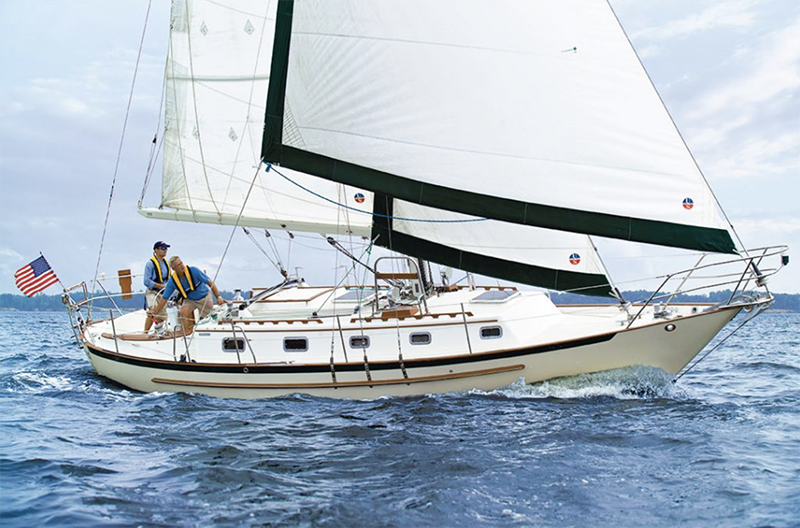
The Pacific Seacraft 37, commonly referred to as the Crealock 37, is an American sailboat meticulously designed by the esteemed British naval architect, W. I. B. Crealock, with a primary focus on cruising. The initial construction of this sailboat commenced in 1978, marking the inception of a vessel renowned for its seafaring capabilities and thoughtful design.
Recognizing its exceptional contribution to sailing, the Crealock 37 earned a prestigious spot in the American Sailboat Hall of Fame in 2002, solidifying its legacy as a vessel of timeless significance within the maritime community.
The Crealock 37, a keelboat primarily constructed with a fiberglass hull featuring a plywood core and adorned with wooden accents, presents a versatile sailing experience. Its masthead sloop rig is complemented by optional configurations, including a cutter rig or yawl rig with a mizzen mast. The vessel boasts a distinctive design, featuring a raked stem, a raised canoe transom, a skeg-mounted rudder controlled by a wheel, and a fixed fin keel. With a displacement of 16,200 lb (7,348 kg) and a substantial 6,200 lb (2,812 kg) of lead ballast, the Crealock 37 ensures stability and seaworthiness.
Offering flexibility, the boat provides a draft of 5.50 ft (1.68 m) with the standard keel and 4.92 ft (1.50 m) with the optional shoal draft keel.
Designed to accommodate up to seven individuals, the Crealock 37 features a versatile layout. The bow offers an angled “V” berth, the main salon provides a double and single settee berth, and the stern houses a double berth alongside a quarter berth. The galley, located on the starboard side at the foot of the companionway steps, includes a double sink, a three-burner stove and oven, and a top-loading refrigerator. The head, positioned forward on the starboard side just aft of the bow cabin, includes a shower. A navigation station is thoughtfully provided aft on the port side, and the vessel ensures ample below-deck headroom of 75 in (191 cm). Ventilation is facilitated by two cabin hatches.
For sailing convenience, the jib is sheeted to short jib tracks, while the mainsheet traveler and three winches are mounted on the coach house roof. Additionally, two primary jib winches are strategically placed on the cockpit coamings.
Length: 37″11′
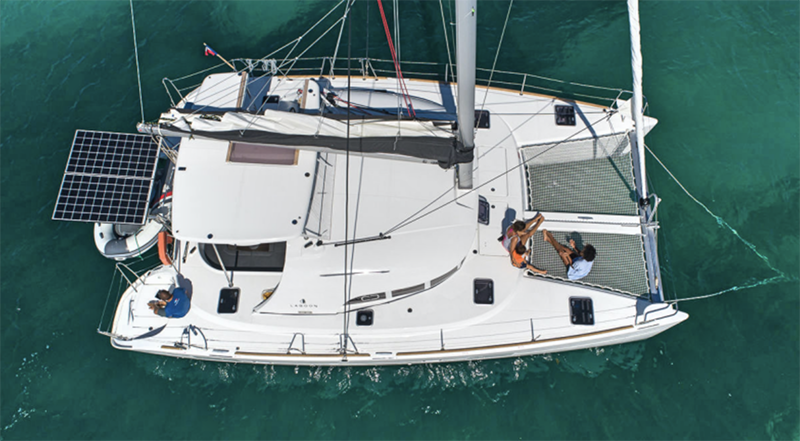
The Lagoon 380, a French sailboat designed by Van Peteghem/Lauriot-Prevost, serves the dual purpose of a cruiser and a yacht charter vessel. This versatile watercraft made its debut in the sailing scene in 1999.
The Lagoon 380 offers a flexible accommodation layout, featuring either three or four cabins designed for private use or yacht charter ventures. In both configurations, a spacious main salon welcomes occupants with an oval table and U-shaped seating. Positioned in the aft starboard section of the main salon, the galley is well-appointed, equipped with a two-burner stove, an icebox, and a double sink. A navigation station complements the galley on the port side of the salon.
In the four-cabin arrangement, each hull houses a double berth fore and aft, accompanied by a centrally located head. The three-cabin layout opts for a larger head in the starboard forward cabin while retaining the port side head. Maximum headroom reaches 80 inches (203 cm) in the main salon and 74 inches (188 cm) in the cabins.
Designed for optimal downwind sailing, the vessel can be outfitted with a 570 sq ft (53 m2) asymmetrical gennaker. The Lagoon 380 exhibits a hull speed of 8.05 knots (14.91 km/h).
Introduced in 2003, the S2 model brought forth several minor enhancements. Notable improvements included a more spacious shower area, enhanced storage shelving, a redesigned galley, and a double helm seat. While Katamarans.com acknowledges these updates, noting them as a marketing refresh, some potential buyers express a preference for the older models due to their increased storage capacity, superior interior finishes, and more straightforward engine access.
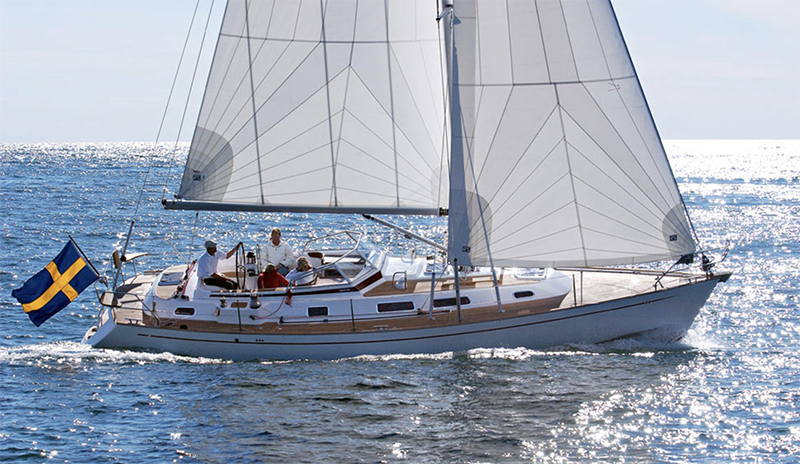
One of our most triumphant yacht designs to date, the Najad 380 is not only an aesthetically pleasing vessel with well-balanced proportions but also delivers remarkable performance for ocean-going ventures. Crafted through vacuum infusion, the yacht boasts a robust and rigid hull, ensuring durability on the open seas. The interior is thoughtfully designed, featuring two sizable double-berth cabins, an expansive saloon, and a fully equipped linear galley, providing an exceptionally comfortable onboard experience.
Gemini Legacy 35
Length: 35′.
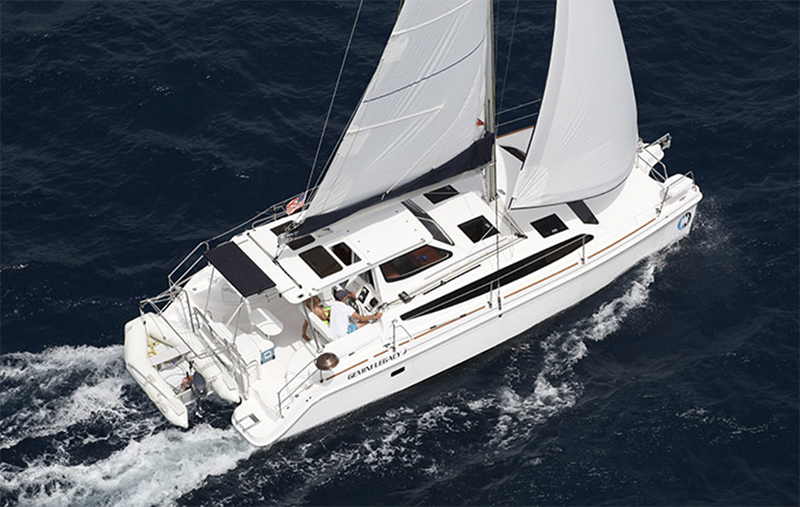
The Gemini Legacy 35 is a bluewater sailboat under 40 feet designed with a focus on stability, safety, and ease of handling. Its catamaran design, with a beam of 14 feet, provides remarkable stability both at anchor and underway. The hulls are constructed using a combination of fiberglass and high-quality materials, ensuring durability and seaworthiness.
The sail plan of the Gemini Legacy 35 features a fractional rig with a large mainsail and a self-tacking jib. The self-tacking jib simplifies sail handling, making it an excellent choice for sailors who prefer ease of operation. The rig design contributes to the catamaran’s overall performance, making it responsive and agile under various wind conditions.
The interior of the Gemini Legacy 35 is designed for comfort and practicality. The saloon, located in the bridgedeck, is bright and open, with large windows providing panoramic views. The settee and dining area are spacious, creating a welcoming and social atmosphere. The galley, positioned for easy access, is equipped with essential amenities, including a stove, sink, and refrigerator.
The catamaran typically offers a three-cabin layout, including a comfortable owner’s suite in one hull and two guest cabins in the other. The cabins feature double berths and ample storage, providing a cozy retreat for extended cruises. The Gemini Legacy 35 can comfortably accommodate a small family or a group of friends.
Length: 37″3′
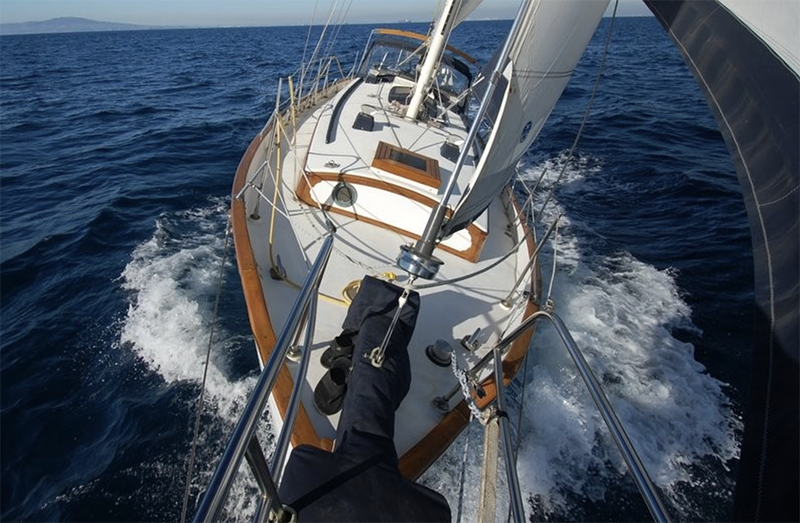
The Tayana 37, originating from Taiwan, is a sailboat penned by American designer Robert Perry, initially conceptualized as a cruiser and first introduced in 1976.
Originally commissioned by Will Eckert of Flying Dutchman Yachts and C.T. Chen of Ta Yang Yacht Building, the design was later acquired by the latter, commencing production under the name CT 37. Initially labeled the Ta Chiao 37 and then the Ta Yang 37, the nomenclature eventually evolved into the well-known Tayana 37.
The interior configuration of the Tayana 37 is adaptable, catering to various rig options and individual preferences. In a typical arrangement, the vessel provides sleeping quarters for seven individuals, featuring a double “V”-berth in the bow cabin, a U-shaped settee with a collapsible dinette table, and a straight settee in the main cabin. Additionally, a pilot berth is situated above, and an aft cabin with a double berth is found on the starboard side.
The galley is strategically positioned on the port side just forward of the companionway ladder, boasting a U-shaped design equipped with a three-burner propane-fired stove, an oven, and a double sink. Opposite the galley, on the starboard side, a navigation station facilitates onboard navigation tasks. The head, located just aft of the bow cabin on the port side, includes a shower with a teak floor grating, complemented by hot and cold pressurized water. Throughout the interior, the trim and doors showcase the craftsmanship of teak.
The Tayana 37 embodies a timeless design that reflects both functionality and elegance, making it a beloved choice among sailors seeking a reliable and comfortable cruising experience.
Fountaine Pajot Lucia 40
Length: 38’6″.
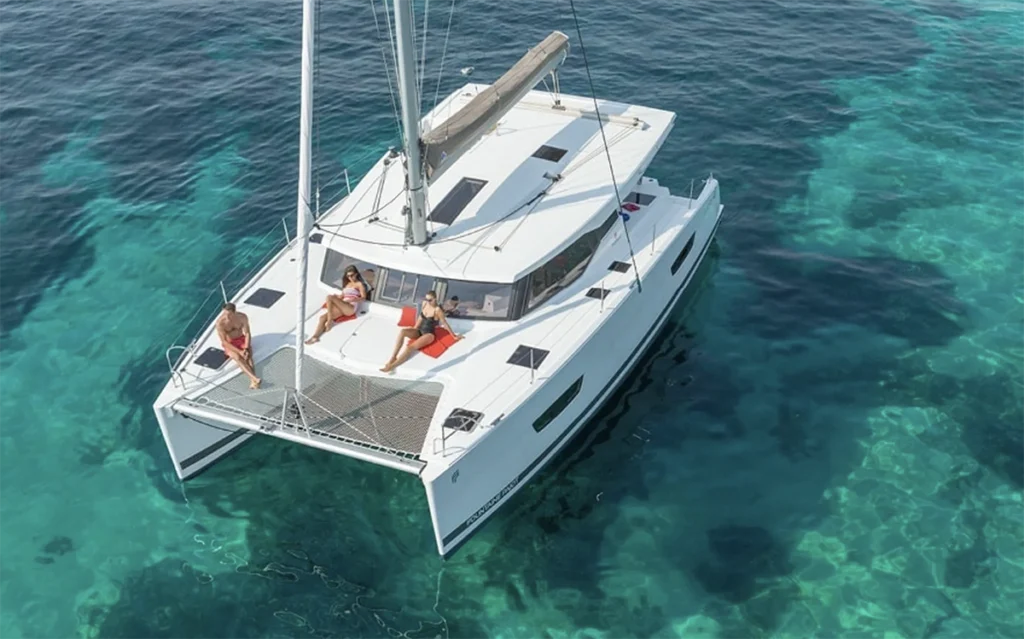
The Lucia 40, designed by Berret-Racoupeau and built by Fountaine Pajot , is a catamaran that exudes contemporary elegance. Its sleek lines, aerodynamic silhouette, and stylish curves not only catch the eye but also contribute to its impressive performance on the water. The use of cutting-edge materials ensures durability and seaworthiness, making it a reliable vessel for extended cruises.
The catamaran’s layout is optimized for comfort, offering spacious living areas both above and below deck. The main saloon is bathed in natural light, creating an inviting space for relaxation and socializing. The interior design reflects a modern and luxurious ambiance, featuring high-quality finishes and attention to detail.
Accommodations aboard the Lucia 40 include multiple cabins, each designed for maximum comfort. The cabins boast generous berths, ample storage, and well-appointed en-suite bathrooms. The vessel’s thoughtful layout ensures that every inch of space is utilized efficiently, providing a sense of openness and airiness.
Island Packet 370
Length: 37’2″.
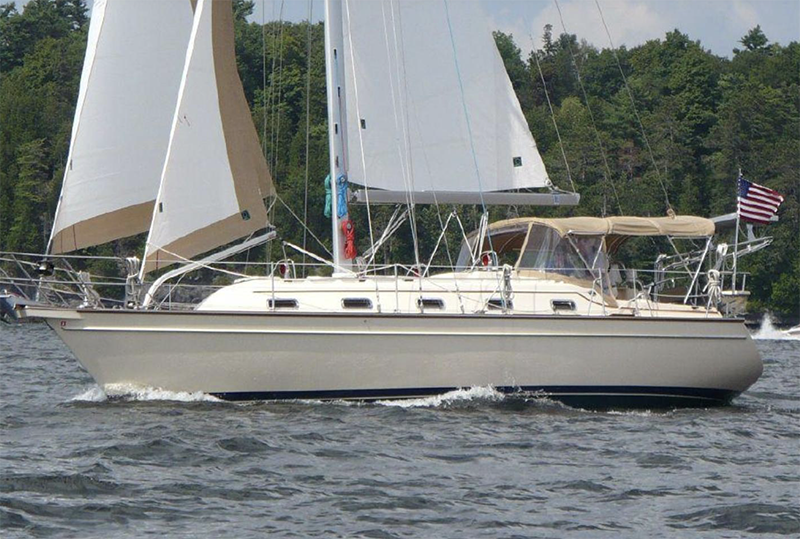
Designed by Bob Johnson, the founder of Island Packet Yachts , the Island Packet 370 boasts a robust construction that prioritizes durability and stability. The vessel’s design reflects a timeless elegance, featuring a moderate freeboard, a well-balanced hull, and a bowsprit that adds a touch of classic charm. The encapsulated full keel enhances stability and ensures a smooth and comfortable ride in various sea conditions.
The interior of the Island Packet 370 is a testament to thoughtful design and attention to detail. The spacious and well-appointed main saloon features a U-shaped settee and a dining table, creating an inviting social space. Rich teak finishes and high-quality craftsmanship permeate throughout, providing an atmosphere of warmth and sophistication.
Accommodations include a generously-sized owner’s cabin forward with an ensuite head, a comfortable aft cabin, and a well-designed galley equipped with essential amenities. The vessel’s layout ensures that every inch of space is utilized efficiently, creating a cozy and practical living environment for extended cruising.
Seawind 1160
Length: 38′.
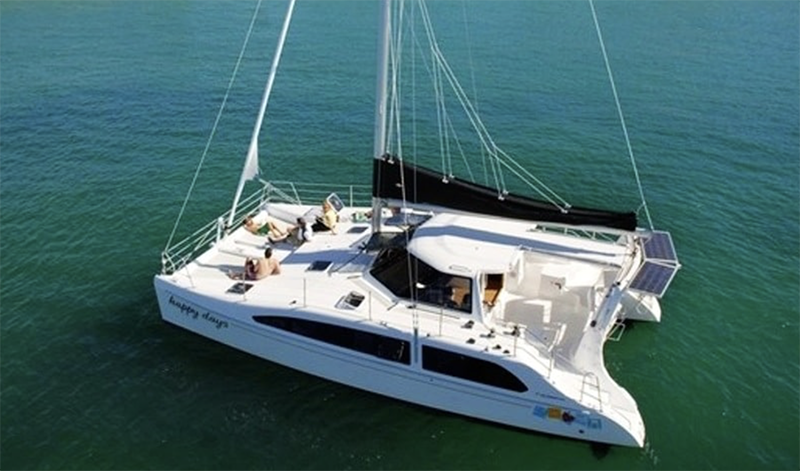
The Seawind 1160 is the perfect cruising catamaran combining the best of the 100’s of Seawind previously built and sailing around the world with new and innovative ideas to keep her light, fast and affordable. Easily sailed by a family, couple or single handed coastal cruising or offshore.
The Seawind 1160 has a spacious owners cabin in the port hull with a queen size island bed and plenty of storage. The three cabin version has an adjoining full size bathroom with separate shower and glass shower screen. The starboard hull has two double berth cabins with optional second bathroom forward and the fully open galley. You have everything you need and enough space to be very comfortable, yet the hulls remain streamline and efficient so that speed is not compromised.
With twin helm stations protected from the weather, all lines leading back to the cockpit and 360 degree visibility, they are set up to be easily handled by a crew of one or ten. The award winning trifold door system allows for indoor/outdoor living like no other boat on the market and is perfectly suited to the Australian climate.
Are you in agreement with our selection of the best 10 bluewater sailboats under 40 feet? It was truly challenging to choose, and we had to set aside models that deserved to be included in this list. If you have any suggestions, please write them in the comments.
New Grand Soleil Blue Will Make its debut at Boot Dusseldorf 2025
Sunreef 43m eco, the world’s largest eco electric catamaran takes shape, comfort meets endurance: the mishi 88’s test of sea-strength, southern wind 108 gelliceaux wins the international superyacht society award 2024, live your passion, subscribe to our mailing list.
Better Sailing

Best Sailboats Under 40 Feet
About five thousand years ago, the Egyptians built sailing ships to navigate the Nile River. Extensive export and import networks started through this and developed international trading routes. Nowadays, sailboats are mainly used for recreational purposes. Sailboats come in a wide range of sizes, from the record-breaking 42-inch yacht up to the 470 feet ‘Sailing Yacht A’, which is the largest in the world. However, I believe that a 30-40 feet sailboat is the best size for a cruising sailboat because sailboats in that category provide the best of everything. They are large enough for bluewater and weekend sailing, liveaboard, and even ocean crossings if built appropriately. This article will look at the 10 best sailboats under 40 feet from around the world.
Obviously, this is a somewhat problematic and unfair comparison because we compare sailboats from 40k all the way up to 400k. For that reason, I tried to be as impartial as possible and include something for everyone. It doesn’t matter if you are looking for a luxury sailboat for your summer vacation or an affordable bluewater cruising sailboat to liveaboard; this list has got you covered. s
Here Are Some Of The Best Sailboats Under 40 Feet
Beneteau Oceanis 40
Price: Used From $80k to $200k
Overall Length: 39.86 Feet
The Beneteau Oceanis 40 is a beautiful sailing yacht. The most popular layout of this model comes with three cabins and two WCs, which makes it perfect for groups of up to 6 guests. This is one of Beneteau’s more popular sailboats ever, with many offers boats available on the used market for sale. She is 39.86 ft long, and it comes with a fin keel. For that reason, this is a fast and easy to handle and maneuver sailboat but not great for ocean crossing and passage making. The Beneteau Oceanis 40 is also great to be used as a liveaboard sailboat under 40 feet because it is comfortable, sails great, and has large big enough fuel, water, and holding tanks. It comes with a Yanmar diesel engine with 40 horsepower, but that is pretty typical for a sailboat that size, so don’t expect to win any races.

>>Also Read: Best Sailboats Under 100k
Price: Used From $200k to $400k
Overall Length: 39′ Feet 4″ Inches
The Dufour 390 represents a perfect match between sailing performance, easy handling, and comfort. Hulls with softened and raised bilge strake, optimized deck plan to take full advantage of your sailing and stopovers. The Dufour 390 stands out as the most well-rounded sailboat under 40 feet. It is a lavishly equipped sailboat with extraordinary style, finished down to the last detail but the best materials on the market.
This Dufour model is an excellent choice for those who love cruising. Like all the designs by this brand, it also offers sailing performance. The Dufour 390 was named European Yacht of the Year in the Family Cruiser category. It is offered in two layout versions with 2 cabins or 3 cabins with two bathrooms; the interiors are cared for and finished with LED lights, USB sockets, and a 40-liter boiler making it a great choice for a liveaboard sailboat under 40 feet.

Beneteau Oceanis 38.1
Price: Used From $60,000, Up To $300,000 New
Overall Length : 37.7 Feet
This is another model being built since the ’90s. Of course, it has been redesigned and evolved over the years to offer more modern looks and higher levels of comfort as accustomed with modern sailboats, but she has remained a great yacht. She is also fast and handles well thanks to her fin keel with and dual rudders. There are many of these sailboats for sale on the used market, with the most popular layout option being with 2 cabins and 1 head.
The Oceanis 38.1 combines useful features, great sailing performance, and style on the under-40-feet category, where function frequently supersedes personalization. Also, her hull offers a surprising cruising comfort. Her rigidity under sail of the Oceanis 38.1 takes her further and faster, with exceptional stability despite her kin keel. It is a real pleasure to have two steering wheels, a mainsail arch, and a spacious swim platform for a sailboat under 40 feet (only on the newer model after 2017).

>>Also Read: Best Sailboat Brands
Jeanneau Sun Odyssey 349
Price: Used From $90k to $250k
Overall Length: 33′ Feet 11″ Inches
The Sun Odyssey 349 is a French sailboat that was designed for cruising and first built in 2014, offering a great combination of speed, comfort, and safety. This sailboat is built by Jeanneau in France and in the United States from 2014 and is still in production. Also, the 349 has a remarkably spacious interior for a sailboat her size, with its most popular layout coming with 3 double cabins suitable for families or groups of up to 6 people. Aboard, you can also find a bathroom, spacious saloon, and galley. Personally, I believe that the Sun Odyssey 349 is a bit small for a liveaboard. Still, I have met people living aboard smaller boats than this one.
The Sun Odyssey 349 can be easily managed by a crew of two or even singlehanded, owing this to her smaller size and lighter weight. She sails well and continues along the brand’s philosophy of building quick and nimble cruising yachts providing entertaining yet safe sailing.
Also, the boat comes with a Yanmar diesel engine of 21 horsepower suitable for docking and maneuvering. Lastly, the fresh water tank has a capacity of 54 US Gallons, the fuel tank of 34 US Gallons, and the wastewater holding tank of 22 US Gallons.

Price: Used From $30k to $120k
Overall Length: 35.92 ft
The Hunter 36 is an American-Made sailboat designed as a cruising sailboat and first built in 1980. Newer versions of this boat are still being made today. It is a Bilge Keel boat and is a good example of how a well-built quick cruising sailboat should be built. Despite the useful bilge keels, this beautiful family cruising sailboat has a good turn of speed and an excellent ability to explore creeks and dry out. The Hunter 36 has an extra-wide beam spanning nearly the entire length of the boat to maximize both headroom and interior accommodations.
Also, her large cockpit gives you loads of room when sailing and lots of comforts when you are ready to sit back and relax. The most popular layout design features two double cabins, one forward and one aft, and a head with a shower. If you are a cruising couple looking for an affordable liveaboard sailboat under 40 feet, you should definitely take a look at this one.

Catalina 36
Price: Used From $30k to $150k
Overall Length: 35.58 ft
This is another very popular sailboat from a very popular brand, especially in the US. The Catalina 36 is an American-made sailboat designed by Frank Butler and Gerry Douglas for cruising and was first built in 1982. This sailboat version was introduced in 1994 and produced until 2005, when it was replaced by the Catalina 375. Catalina made over 2,300 of these boats, many of which are on sale today for very affordable prices.
This sailboat is a very fast and seaworthy family cruiser with a spacious cockpit that can easily be used singlehanded since all trim lines and halyards lead to the cockpit. The fin keel and spade rudder allow for easy maneuverability in tight marinas; however, it does not make a great boat for offshore bluewater cruising and passage-making.
The interior space is lovely, with high-quality materials and teak carpentry throughout. Also, thanks to its big U-shaped galley, two-burner natural gas stove and oven, large stainless steel sink, a spacious top-loading refrigerator, plenty of counter space, and generous storage make the Catalina 36 an excellent option for a liveaboard sailboat.

>>Also Read: Best Sailboats Under 30 Feet
Bavaria Cruiser 37
Price: Used From $60k to $220k
Overall Length: 37 Feet 1 Inches
The Cruiser 37 is a series sailing yacht from the German manufacturer Bavaria Yachtbau. It is a cruising sailboat for sailors who like to move fast through the water but also seek a high level of comfort for their vacation. On the inside, the Cruiser 37 seems bigger than you would expect from a sailboat under 40 feet with more storage spaces that one could think it would also work as a liveaboard. This is a very popular sailboat that Bavaria started building in the early 2000s’ and is still being produced.
There are two versions of the keel; a shallow keel with a 5 Feet draft and a normal version with a 6 feet draft. There is also a standard version with two cabins that sleep 4 people and a charter version with three cabins that sleep 6.
In the saloon, you will find the L-shaped galley on the starboard side. This is followed by the seating bench with the saloon table. Opposite to port is also a seating assembly, the third seat of which can be pulled out. If it is lowered, you can sit in front of a navigation table. This should create space for six people in the saloon.

>>Also Read: Best Pocket Cruisers Under 20 Feet
Price: Used From $25k to $250k
Overall Length: 35 Feet
The Dehler 34 was first introduced in 1986. The boat’s overall length is 35 feet and 1.2 inches and costs from $50,000 to $250,000 depending on the built year. This boat was an awardee of the “Best Performance Cruiser” in the “Boat of the Year” (BOTY) contest in 2017. The Dehler 34 sets high standards with its interior space and built quality. It has a spacious living area for liveaboards, a pull-out bar, premium lighting, and an elegant ambiance to indulge you throughout your cruise. The Dehler 34 showcases generous headroom, tank sizes and offers an outstanding sailing performance.
Designed by a naval- architecture consortium- Judel/Vrolijk, the Dehler 34 is sturdy, stable, and strong, making sailing safer and letting you sail higher into the wind. However, the Dehler 34 comes with a fin keel, which doesn’t make it ideal for passage making. There is a long argument to be had here, but I prefer bluewater sailboats to have full keels.

>>Also Read: Best Small Full Keel Sailboats To Sail Around The World
Alerion Sport 30
Price: Around 250k New
Overall Length: 30 Feet
Alerion yachts have a classic, graceful design that features varnished teak, oval ports, and lovely deck overhangs with a modern underbody. The more recent 30 feet Alerion Sport 30 features a faster, lighter, technology-laden boat. It sells for about $236,500. The Alerion Sport 30 is the first Alerion sailboat with a carbon-fiber bowsprit option, which keeps the construction lightweight but robust, enhancing its performance. Even with all these advanced features, the Alerion Sport 30 is unbelievably easy to sail. This timeless beauty offers sitting headroom with an open berth and a spacious cockpit that can seat 3-4 people. All in all, the Sport 30 is an adequately equipped sailboat with deluxe comfort and experience for all sailors.

Price: Used From $125k to $200k
Overall Length: 34 Feet
Hanse 348 is a 34-foot sailboat with a price tag of about $200,000. It won the award of the “Boat of the Year” in 2019. With a higher rig and a sportier sail plan, Hanse 348 is packed with excellent performance. It offers fast cruising without compromising the sailor’s comfortable sail experience. This boat showcases a clutter-free deck with beautiful woodwork, giving it a wholesome elegant look. Below the deck, you can find three double cabins with a generous amount of windows. The windows offer ample lighting and creating a sun-filled lounge. With an abundance of space for a large crew, you get the opportunity to have a great time staying on the water.

Also Read: Best Liveaboard Sailboats
Final Thoughts
These sailboats under 40 feet offer different features to different sailors, but all of them tick some essential boxes. They are built with the best and high-quality materials. All of them are seaworthy to help you enjoy your time on her, whether liveaboard full-time or offshore bluewater sailing. With the perfect sailboat, you can experience unparalleled peace and comfort while sailing through the waters.
Peter is the editor of Better Sailing. He has sailed for countless hours and has maintained his own boats and sailboats for years. After years of trial and error, he decided to start this website to share the knowledge.
Related Posts

The Ultimate Guide to Choosing the Best Fishing Line for Trolling

Lagoon Catamaran Review: Are Lagoon Catamarans Good?

Best Inboard Boat Engine Brands

Are O’Day Sailboats Good? A Closer Look at a Classic Brand
- Buyer's Guide
- Destinations
- Maintenance
- Sailing Info
Hit enter to search or ESC to close.
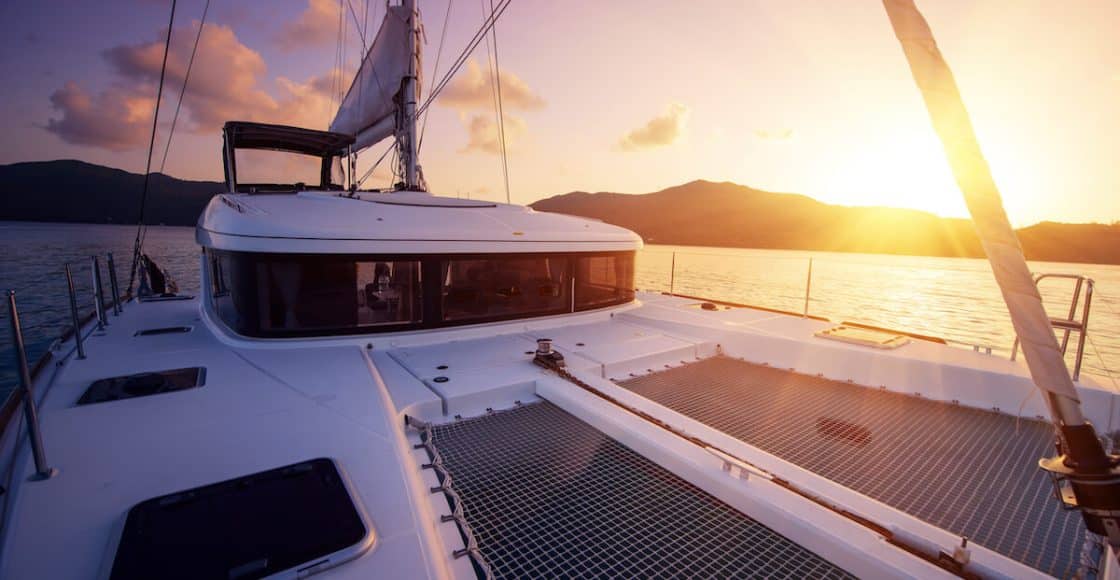
5 Best Liveaboard Boats
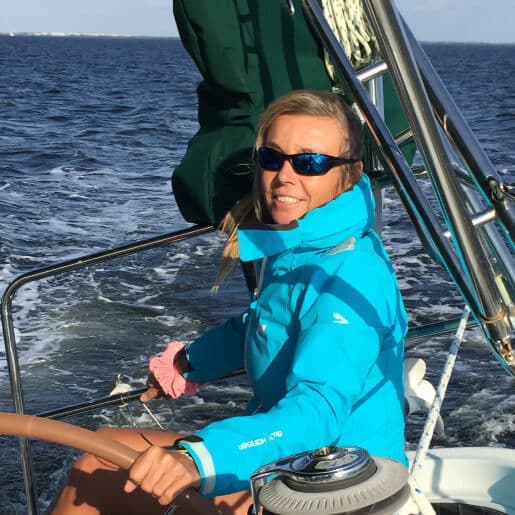
Table of Contents
Last Updated on November 3, 2023 by Boatsetter Team
Want to live aboard a boat? Maybe you’re looking for more affordable waterfront living, or an alternative lifestyle – either way – living on a boat has many rewards. That said, choosing the right boat will make all the difference to your happiness. Before you commit, consider these five best liveaboard boats :
- Motor yachts and cabin cruisers
- Trawlers
- Sailboats
- Catamarans
- Houseboats
Find Live Abroad Boats ready for rent here
Motor yachts and Cabin Cruisers
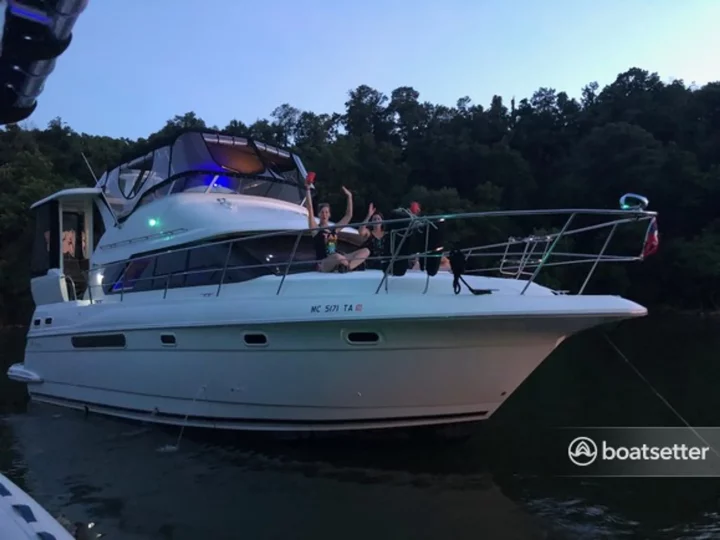
Motor yachts is a broad term that encompasses large(ish) motorboats with accommodations like a bed (sleeping cabin), a head (bathroom), and a galley (kitchen). These boats can be quite large such as an Absolute 50 with a flybridge that provides extra space for outdoor recreation/entertainment, like the backyard of a house.
Models like these usually have three cabins and two heads to accommodate an entire family. Of course, big boats come with big price tags and lots of maintenance needs, so you may not save much over living in a condo.
Consider how much space you need and check out some best liveaboard boats under 40 feet. Cabin cruisers like the Cutwater 32 are great choices. This boat has one cabin as well as a galley and lounge area (living room) with large windows that bring in lots of natural light and air.
The twin outboard engines can transport your home to new surroundings in the blink of an eye. Best of all, boats under 40 feet may save you a million dollars (literally) over large motor yachts and provide many of the same amenities.
2. Trawlers
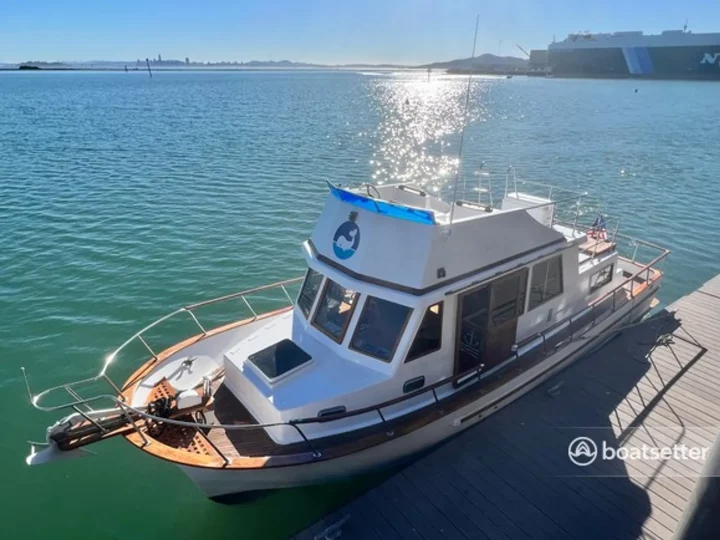
Trawlers are a great option because they are built with the liveaboard lifestyle in mind. They’re typically slower boats designed for long-distance cruising, and they come in many sizes from a large Nordhavn 60 built for tough ocean conditions to a more compact Beneteau Swift 35 that’s ideal for coastal cruising.
Most trawlers have good liveaboard layouts and will travel at speeds 8-10 knots, where they offer good fuel consumption , which is important with high diesel prices.
Pro Tip: Not all trawlers are slow – the French Swift series is designed to run at planning as well as trawling speeds, so you get the best of both.
READ MORE: Don’t Ignore Your Bucket List: Great Loop
3. Sailboats
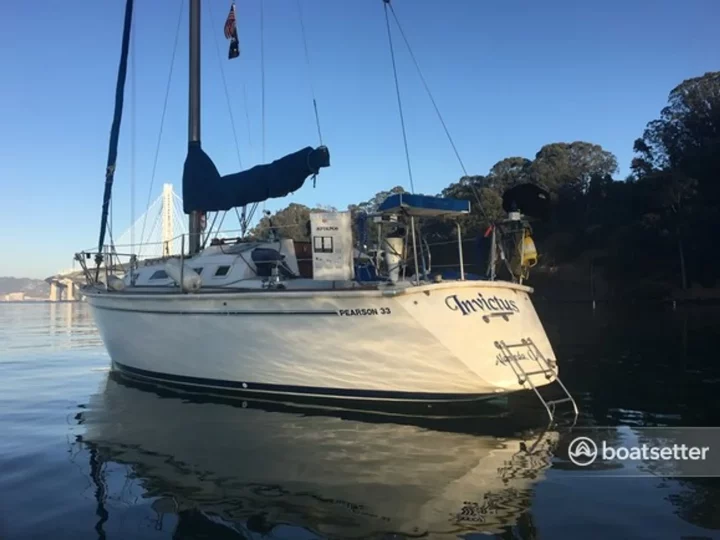
Perhaps you’re contemplating living aboard in preparation for long-distance cruising under sail. Sailboats come in all sizes, just like motor yachts, but they’re usually narrower, and most of the living aboard happens lower down in the boat, so they’re not as airy and light.
On the plus side, because space is more premium, sailboat design is very efficient, so you can pile a lot into a sailboat and still have room for sailing necessities.
Looking for a compact sailboat? Consider the Jeanneau Sun Odyssey 380 with two or three cabins in just 38 feet. For something a bit roomier, check out the new Hanse 510 . This massive model can be spec’d with up to five cabins and even has a tender garage.
The great thing about sailboats is that you can travel long distances when you want to change your neighborhood entirely – and with little money spent on fuel.
4. Catamarans
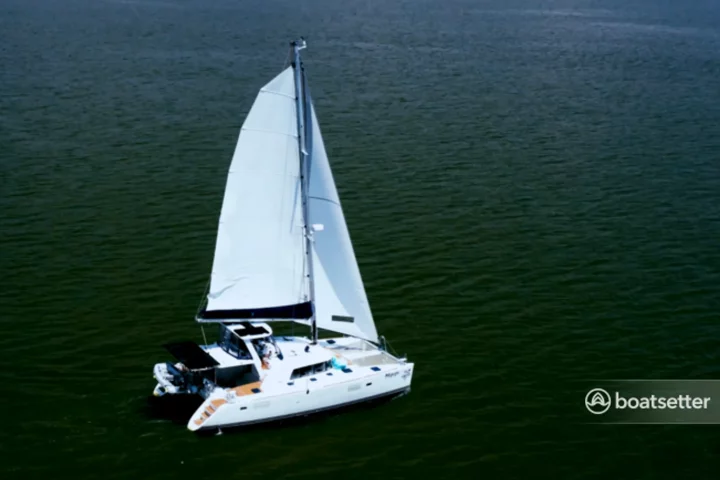
Catamarans are boats with twin hulls and they can be both power and sail models. They have many advantages including more room aboard than the same-length monohulls with better cabin privacy and more system redundancy for backup options.
They’re more stable both in motion and at anchor (dock) so they produce less seasickness and are more comfortable in a rolly anchorage at night. They’re roomy platforms for kids as well as older folks but due to their beam (width), it’s harder to find a slip for them in a marina.
Sailing cat models come in various sizes and prices. Production boats like the Fountaine Pajot Isla 40 and the Excess 11 are both around 40 feet but feel much bigger than a monohull sailboat of equal length.
Many cats come in an “owners’ version” where one entire hull is dedicated to the master suite which is like a bedroom at home. Models like these start around $500,000 but upmarket, carbon fiber, semi-custom designs like the HH55 will set you back multiple millions.
Powercats are growing in popularity and offer the same amenities as their sailing counterparts, except they have bigger engines to travel at much greater speeds. Powers can be on the smaller side, like the 32-foot Aspen C100, or quite sizeable, like the Aquila 54. Cats tend to be more expensive to purchase and to own since there are two of just about everything to maintain.
5. Houseboats
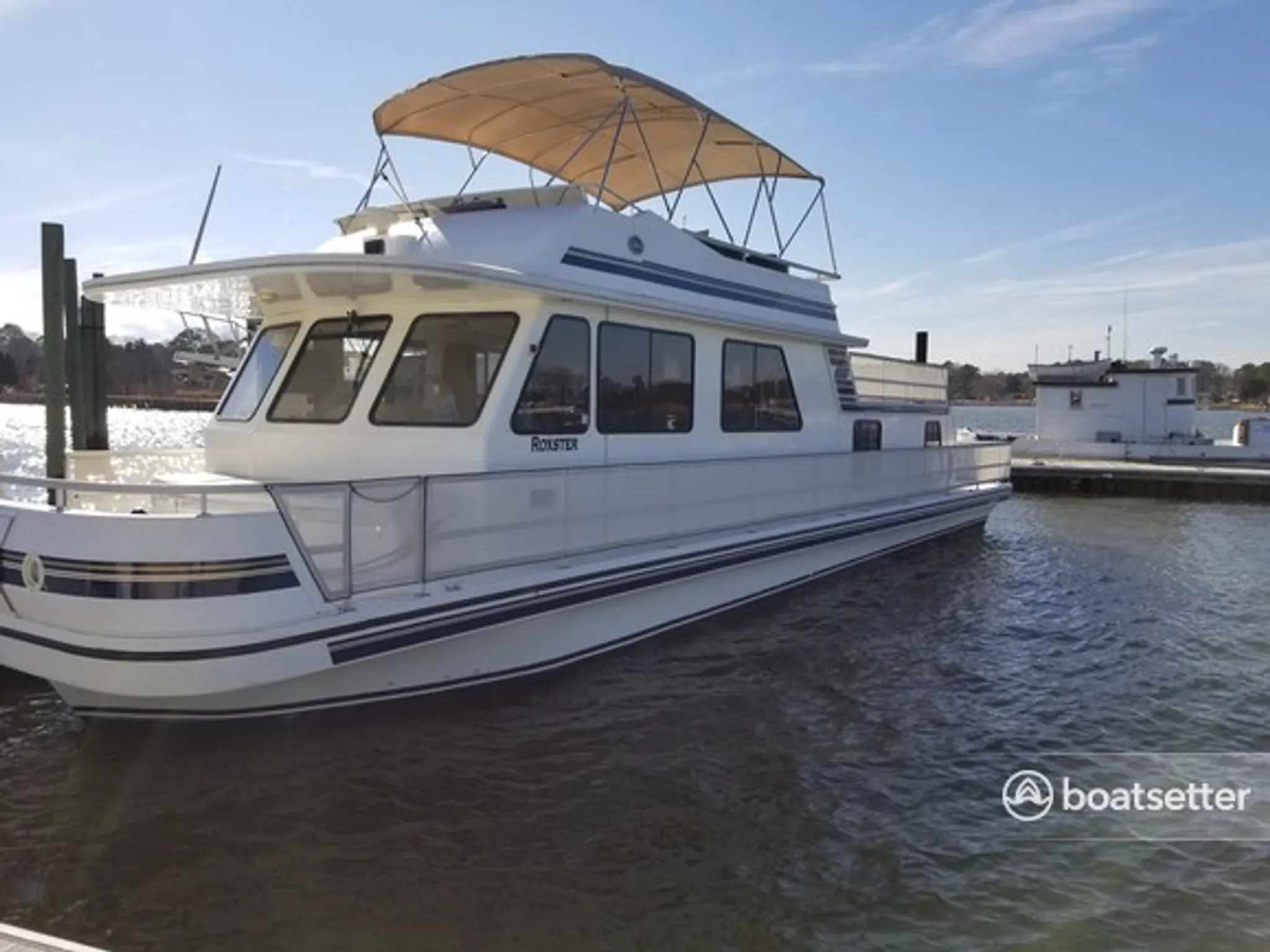
If you want to live aboard but have little interest in being mobile, you may consider a houseboat. These boats usually maximize living space and are shaped more like houses than boats. Household-sized amenities, including side-by-side refrigerators, massive sofas, and large TVs can be had.
Because they don’t require much technical gear like engines, electronics, and advanced power systems, houseboats can be quite affordable and can make the best liveaboard boats under $100k.
A few companies build houseboats like Eco-Sea Cottages, but many will be one-off and home-built designs. Although these boats don’t move (much), they must still have a solid floating foundation to be safe, and only some marinas will allow them to dock there.
One more thing to consider
There are no hard rules as to what makes a great liveaboard boat! You just have to find one that suits you and your budget. Read our Living on a Boat post for more insight, and be sure to browse through Boatsetter to find the perfect liveaboard boat.
About Boatsetter
Boatsetter is a unique boat-sharing platform that gives everyone — whether you own a boat or yyou’rejust renting — the chance to experience life on the water. You can list a boat , book a boat , or make money as a captain .
List. Rent. Earn— Only at Boatsetter

Zuzana Prochazka is an award-winning freelance journalist and photographer with regular contributions to more than a dozen sailing and powerboating magazines and online publications including Southern Boating, SEA, Latitudes & Attitudes and SAIL. She is SAIL magazines Charter Editor and the Executive Director of Boating Writers International. Zuzana serves as judge for SAIL’s Best Boats awards and for Europe’s Best of Boats in Berlin.
A USCG 100 Ton Master, Zuzana founded and manages a flotilla charter organization called Zescapes that takes guests adventure sailing at destinations worldwide.
Zuzana has lived in Europe, Africa and the United States and has traveled extensively in South America, the islands of the South Pacific and Mexico.
Browse by experience
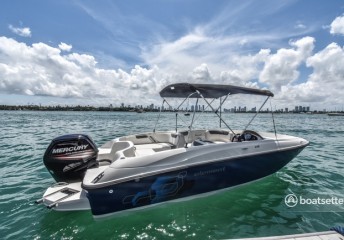
Explore articles
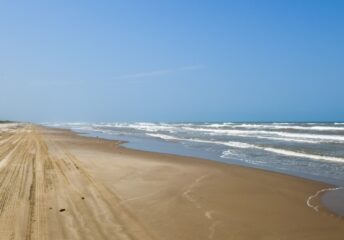
Top 5 Beaches in Texas
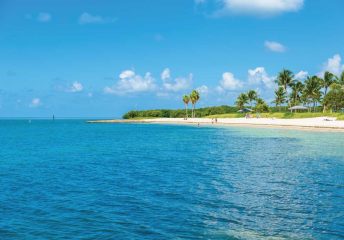
Marathon, FL Boating Guide
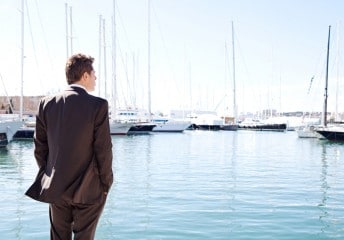
Is Buying a Boat the Right Investment?
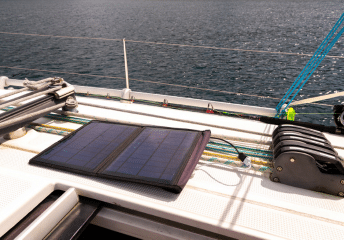
5 New Tech Toys that Will Upgrade Your Boat Part 2.
- BOAT OF THE YEAR
- Newsletters
- Sailboat Reviews
- Boating Safety
- Sails and Rigging
- Maintenance
- Sailing Totem
- Sailor & Galley
- Living Aboard
- Destinations
- Gear & Electronics
- Charter Resources
- Ultimate Boating Giveaway

25 Sailboats Under 40′
- By Cruising World Staff
- Updated: March 25, 2014
Catalina 275 Sport

“This is a complete package; it’s a good sailing boat and well-thought-out. It’s definitely ready for prime time,” says Boat of the Year judge Ed Sherman. Click here to read why the Catalina 275 Sport won Best Pocket Cruiser in 2014.
Beneteau First 30

As they approached the First 30 to conduct their dockside evaluation during the boat show, the BOTY judges may have been just a little skeptical of this performance-oriented 30-footer’s cruisability. But that skepticism turned into appreciation as soon as they stepped below, and they were downright enamored with how the boat sailed. Click here to read why the Beneteau First 30 won Best Small Cruiser, 20 feet and Under in 2011.

The Presto 30 is an innovative, well-built, good looking cruising boat that satisfied its stated design brief as well as any other boat the judges looked at, though it’s not what you might expect from an average cruising boat. Cruising World judges also noted that this easy-to-handle boat may attract new sailors to the sport so they can learn the ropes and then trade up to another model, an approach that’s important to the health of the entire industry. Click here to read how the Presto 30 won the Cruising Spirit Award in 2011.
Catalina 309

“I think that for the purpose it was put on the water, to be able to walk down, jump aboard, and simply go enjoy it on a weekend, the boat not only hit the price in terms of value but also hit the mark in terms of use,” remarked judge Alvah Simon, a world voyager. Click to read why the Catalina 309 won Domestic Boat of the Year for 2007 .

The J/95’s retractable centerboard and dual rudders make it possible to sail in just 3 feet of water. During our dockside visit, designer Rod Johnstone told us that he wanted to build a comfortable coastal cruiser that could keep people sailing by providing “high performance in shallow water,” and the J/95 did exactly what Rod said it would. Click here to read how it won Best Weekender and Domestic Boat of the Year for 2010.
Catalina 315

This nifty pocket cruiser raises the Catalina quality bar with more comfort and better performance. It’s the little things that make this boat special, including the tall rig, the wide cockpit, the large anchor locker, the sprit for the asymmetric kite, and the clever use of space below. Click here to read how the Catalina 315 won Best Inshore Cruiser for 2013.

The Delphia 33 is a boat that’s maximized every inch of available space, and the overall fit and finish, from the joiner work to the systems installation to the structural integrity of the boat, is well done. Click here to read why the Delphia 33 won Import Boat of the Year in 2008.

“With this introductory cruiser, Hunter is trying to bring people up through its ranks and into cruising from trailer-sailers and smaller boats,” said Alvah Simon. “And the company has done that with a 33-footer that has quality and affordability but is still manageable and unintimidating.” Click here to read why the Hunter e33 won Best Compact Cruiser for 2012.
C&C 101

The 33-foot C&C 101 boasts thoroughly modern lines and a nice turn of speed but also features a fine layout belowdecks, with cherry furniture and a teak cabin sole. Click here to read why the C&C 101 won Domestic Boat of the Year and Best Performance Cruiser in 2013.

This dual-purpose cruiser is both easy to handle and zippy on the racecourse. Click here to read why the X-34 won Best Racer-Cruiser for 2009.
Beneteau 34

This affordable performance cruiser is a blast to sail, with details often lacking on more expensive boats. Click here to read a boat review of the Beneteau 34. Click here to read why the Beneteau 34 won the award for Best Value in 2009.
Tartan 3400

The Tartan 3400, with double cabins fore and aft, was still sufficiently nimble and distinctive to cop the 2006 Boat of the Year award for Best Production Cruiser from 31 to 36 Feet. Click here to read more.

The BOTY judges found lots on which to agree as they proclaimed the Najad 355 to be the Best Small Cruiser of 2008: great sails, solid motion through the water, practical interior, well-laid-out deck. Click here to read more.
Catalina 355

Two themes—consideration and principles—epitomize the Catalina 355. Click here to read why it won Domestic Boat of the Year in 2011.
Sabre Spirit

Andrew Burton found the 36-foot Sabre Spirit boat not only easily handled and fast but also a sheer delight to sail; no wonder it won the Judges’ Choice Award in Cruising World’s 2008 Boat of the Year contest. Click here to read more .
Island Packet Estero

Comfortable surroundings are easily driven by a fully self-tending and roller-furling rig on the 36-foot Island Packet Estero. Click here to read why it won Best Midsize Cruiser Under 40 feet in 2010.
Hallberg-Rassy 37

Like the Swedes who manufacture it, the Hallberg-Rassy 37 is a hardy sailer. The boat’s seakindly performance gives the assurance that it can take you anywhere, and once you get aboard, that’s exactly where you’ll want to go. Click here to read why it won Import Boat of the Year in 2006.
Malö 37 Classic

This purpose-built craft is a dream to steer and a delight to the eyes. Click here to read how it won Import Boat of the Year for 2009. Click here to read a full boat review.
Catalina 375

Solid construction and thoughtful amenities make life onboard this boat more comfortable. Click here to read why the Catalina 375 won Best All-Purpose Cruiser, 30 to 40 Feet in 2009.
Jeanneau Sun Odyssey 379

This midsize offering from Jeanneau has a modern look and is ready for sea. Click here to read why it won Domestic Boat of the Year and Best Midsize Cruiser for 2012.

“This very responsive sailboat scoots along quite nicely, I think as well as anything we sailed in this fleet,” says Boat of the Year judge Mark Schrader. Click here to read why the Dehler 38 won Best Cruising Sailboat Under 38 Feet in 2014.

Better-than-expected performance, good design ideas, and follow-through in their execution led to the Hunter 38 winning Best Production Cruiser Under 40 feet for 2005. Click here to read more.

Who says a cruising cat under 40 feet isn’t big enough for comfortable accommodations? The 38’s hulls are narrow where they meet the water for performance purposes but flare out to create ample interior space. Click here to read why the Leopard 38 won Import Boat of the Year in 2010.
Seawind 1160

This 38-foot cat will appeal to cruisers who want a well-built boat that can sail away in a hurry. Click here to read why the Seawind 1160 won Best Multihull Cruiser and Most Innovative Boat for 2007.

“The company is mixing traditional aesthetics with modern gear–from the carbon rudder to tweakers on the jib tracks, and it works really well,” said Boat of the Year judge Steve Callahan of the Sabre 386. Click here to read why it was named Domestic Boat of the Year for 2005.
- More: 21 - 30 ft , 31 - 40 ft , Boat Gallery , Boat of the Year , Photo Galleries , Sailboat Reviews , Sailboats
- More Sailboats

Sailboat Review: Dragonfly 40

Elan Impression 43: A Family-Friendly Cruiser with Serious Sailing Performance

Cruising World ’s 2025 Boat of the Year Competition

2025 Boat of The Year: Best Overall

Cruising with Confidence: How Modern Boats Are Measuring Up

Sailor & Galley: Easy Pink Aioli Dip

Reefs at Risk: How Cruisers Can Champion Ocean Conservation
- Digital Edition
- Customer Service
- Privacy Policy
- Terms of Use
- Email Newsletters
- Cruising World
- Sailing World
- Salt Water Sportsman
- Sport Fishing
- Wakeboarding
Practical Boat Owner
- Digital edition

Best second-hand sub-40ft liveaboard boats: sail and power
- Duncan Kent
- August 19, 2024
Seasoned boat tester Duncan Kent chooses the sub-40ft power and sailing boats most suitable for long-term living aboard

The Beneteau Oceanis 351 has a masthead rig with deck-stepped mast. Credit: Paul Wyeth Credit: Paul Wyeth
The best second-hand sub-40ft liveaboard boats: sail and power
Under 25ft, cruising yachts rarely offer standing headroom, making it tricky for cooking or dressing, not to mention the chronic back ache from constant stooping.
Headroom should be a priority on liveaboard boats.
Cruising for extended periods also requires some ‘normality’ in your facilities, so you feel relaxed about washing, dressing, cooking and eating.
Sleeping quarters can be rudimentary, provided the berths are large enough and well padded, but lack of space in the galley and heads often causes frustration.
The key to a successful liveaboard galley is plenty of prep space and stowage.
Most boats use bottled gas (LPG) for cooking. If you plan to live mainly in a marina, however, you can use an electric hob, microwave and air fryer.
Privacy is rare on a small boat, but a separate heads compartment is vital unless you live alone.

Saloon settees make good berths on liveboard boats, especially if crew suffer from seasickness. Credit: David Harding
An electrically pumped hot water system is also needed if you want to shower on board, along with a large waste tank.
Though most sailors navigate from a display in the cockpit these days, a decent nav station is useful.
Having a dry, secure area to passage plan and check/log your course is important. Plus, it’s a perfect spot for non-waterproof comms equipment such as a laptop.
Saloon settees can make good berths and are often better for anyone prone to seasickness, as they impart the least motion.
Voluminous aft cabins with wide berths are fine at anchor or in a marina, but often not useable at sea, especially transverse berths. And forepeak bunks are undoubtedly the noisiest and most affected by slamming and wave motion.
On smaller boats, the cockpit will inevitably become part of the accommodation, so a good tent with see-through panels is invaluable.
In terms of comfort and security at sea, high coamings and a deep, well-drained footwell are preferable.
At anchor, though, the bigger the cockpit the better, so a compromise is required.
Catamarans have an edge on the equivalent length monohull; their wide, flat-bottomed hulls easily house double berths and luxurious heads.
Liveaboard boats: 25-30ft LOA
Sailing yachts.
The Jeanneau Sun Odyssey 29.2 ’s spacious cockpit and roomy accommodation provide a good level of home comfort.
Her saloon has a straightforward layout with a central table and two straight settees, allowing six to be seated comfortably.
The galley is compact but easily workable with a cooker, sink, cool box and nearby stowage.
Opposite is a forward-facing chart table with room for instruments and a dedicated seat. The sleeping accommodation is where she excels.
The large aft cabin spreads across two-thirds of the stern and contains a spacious double berth, hanging locker and dressing area.

Liveaboard boats: Jeanneau Sun Odyssey 29.2’s sleek hull is fun to sail but stable enough for family cruising. Credit: David Harding
In the other quarter is a roomy heads compartment with a shower, sink, toilet and wet locker.
While there’s no floor area in the forecabin with the infill in place, the berth is a good size and comfortable and there’s ample storage beneath it.
On deck, the 29.2’s large cockpit is ideal for entertaining in good weather while remaining safe and practical at sea.
Her side decks are wide and uncluttered and provide easy and safe foredeck access.
She was available with a fixed fin keel or stub keel with centreboard for those wanting to sail in shallow waters.
Her hull is sleek and easily driven , which results in an exciting performance under sail while remaining safe and stable for family cruising.
Tiller steering was standard but there was a wheel option.
Twin rudders keep her directionally stable even when heavily heeled and her powerful fractional rig carries more than enough sail to keep her gliding along at a respectable speed in light airs.
Being quick, yet agile and well-balanced, they’re easy to sail single-handedly without drama and are surprisingly close-winded thanks to the coachroof-mounted jib sheet tracks.
Modern and spacious, the Bavaria 30C offers big boat comforts in a compact and affordable package.
She has an open, bright, yet woody interior with plenty of opening portlights and lots of useful stowage, including lockers above the saloon settees.
Unlike the 29.2, Bavaria only built the 30C with a two-cabin layout.
She has a well-equipped galley with a full-size cooker, a deep fridge/cool box, a sink and plenty of space for cutlery and crockery.
Opposite is a nav station worthy of a 35-footer, with a seat, drawers under, chart stowage and instrument mounting space.
Behind this is the door to the heads, which is a little small, but still has a shower.

Liveaboard boats: A conventional all-rounder, the Bavaria 30C is well-balanced and agile. Credit: Marco McGinty/Alamy
The saloon is cosy yet spacious. Long, straight settees allow six to eat together in comfort around the drop-leaf table, or two to bed down at night.
The two cabins are surprisingly roomy, both offering comfortable double berths for tall adults and good-sized lockers.
While her cockpit isn’t massive, it’s ideal under sail and the table and binnacle provide extra support.
At anchor , it doesn’t offer a huge lounging area, but it’s fine for four to relax and watch the sunset.
Over the years, Bavarias of all sizes have been thrashed to within an inch of their lives by charterers, and survived relatively unscathed, which says a lot about their build and seaworthiness.
The medium displacement 30C is agile and well-balanced, quick to tack, points well upwind and is fun to sail.
She is easily handled by any member of the crew, including young learners, and keeps sailing in the gentlest of breezes.
The first Hurley 30/90 was launched in 1974 and sported a shallow fin keel containing 1.7t of encapsulated lead ballast and a skeg-mounted rudder.
She’s comfortable and practical to live on for extended periods, and steadfast enough to undertake a lengthy offshore passage.
Thanks to her comparatively wide beam it is roomy down below. The sleeping accommodation is comfortable, though rudimentary.
The forepeak vee-berth is a little short, but the port settee converts into a comfy double and the quarter berth is a good size.
Headroom is a generous 1.90m/6ft 3in everywhere except the forecabin.
The heads is forward of the saloon and has a pull-out sink, though showering space is limited.

Liveaboard boats: The Hurley 30/90 (30ft/9m) was the largest of Ian Anderson’s designs for Hurley. The boat was later known as the Anderson 30 after Ian Anderson bought the moulds and began producing the boats. Credit: David Harding
Her cockpit is wide and long, with a cut-away aft, and though her vertical transom makes boarding from the water awkward, it’ll save on marina fees.
There’s abundant stowage in deep lockers plus cave lockers for smaller items.
The primary winches are well forward on the coamings and her mainsheet track is on the bridge deck.
While neither presents a problem with a tiller helm, both are out of the helmsman’s reach in the wheel version.
She has a stout masthead rig with a tall, deck-stepped mast. This provides a high-aspect sail plan that keeps the boom short and clear of the cockpit.
As in most boats of this era, the bulk of the driving power comes from her ample genoa.
She is a cruising yacht and as such, her round-bilged, full-bellied hull creates some drag under sail.
That said, her relatively high displacement means she exhibits a sea-kindly motion and carries well when the going gets choppy, resulting in good passage times, even in heavy seas.
The original 12hp Yanmar diesel engine was a little underpowered and the prop is slightly offset, which can make her tricky to manoeuvre.
Built over 20 years ago, the high build quality of the Swedish-built Nimbus 280 Coup e means she still feels ‘new’.
Though not cavernous inside, the 280C has a place for everything and makes a very comfortable floating home for a couple, with room for three overnight guests on the convertible saloon dinette and a single berth beneath the saloon sole.
When the weather is good you can slide back the saloon doors and wander freely between the saloon and the spacious cockpit, which is as well laid out with a padded L-shaped bench surrounding the removable dining table.
Inside, it’s bright and airy due to the sliding glass roof lights and tall side windows with opening sections.
The raised helm seat is very comfortable and offers an excellent all-round view while being an easy reach to instruments and displays.
The double navigator seat can convert to a dinette seat or go completely flat for sleeping.

Liveaboard boats: With a clean hull, the Nimbus 280 Coupe will cruise comfortably at 14 knots. Credit: Claire Frew/Future
Opposite the dinette is one of the most well-equipped galleys I’ve seen on a 28-footer, complete with a large cooker/oven, fridge, sink and worktop, and numerous drawers and shelves.
Below, she has a large double berth forward that is roomy and practical, with space for storing clothing and shelves for smaller items.
In the corridor is access to the single berth under the saloon sole. Opposite is the heads which, though not massive, is big enough for a decent shower.
The 280C has a 150hp Volvo Penta TAMD31 shaft-driven inboard diesel engine, capable of a 14-knot cruise speed and a top speed of 18-knots with a clean hull. Cruise fuel consumption is around 22lt/h.
She’s a good performer in most conditions and handles heavy seas with ease.
Liveaboard boats: 31-35ft LOA
The Polish-built Delphia 33 is a roomy, mid-range family offshore cruiser offering six berths in two double cabins plus the saloon, and 1.83m/6ft headroom.
The accommodation is a good size and ideal for a liveaboard couple with occasional guests. The quality of the mahogany woodwork is excellent, though a little dark.
However, the abundant light entering from the large windows makes her cosy rather than gloomy inside.
Rather than providing twin aft cabins and squeezing the heads into the saloon area, Delphia opted to install the heads where the second aft cabin could have gone.
This opens the boat up, leaving almost as much living space as a 36-footer.
For those happy with two cabins this is a sensible use of space and leaves room for a proper, forward-facing navigation station.
The saloon has seating for six, and the port settee can be converted to a double berth.
The L-shaped galley includes a two-ring cooker/oven, twin sinks, and a fridge. On deck, her streamlined coachroof melds gently into the foredeck.
Her side decks are wide, and the transom has steps down to a narrow bathing platform, with a boarding ladder and hot water deck shower.

Liveaboard boats: All the sailing controls are led aft to the coachroof, making the Delphia 33 ideal for short-handed sailing. Credit: David Harding
Her cockpit is quite wide, with the genoa winches on the coamings and two self-tailing halyard winches on the coachroof.
All the sail controls are fed aft through clutches, including the mainsheet traveller.
Her 7/8ths fractional rig uses a deck-stepped mast with swept spreaders and an optional backstay adjuster. The sail plan comprises a semi-battened mainsail with two single-line reefs and 115% furling genoa.
The 33 is a very competent performer under sail without being hard to handle or at all twitchy.
The deep, bulbed keel keeps the ballast down low, so she’s stiff under sail, plus her deep spade rudder provides maximum grip on the water.
A Laurent Giles design from 1980-1984, the Westerly Discus utilised the hull of the earlier 33 but with different deck options.
She was offered in aft-, or centre-cockpit format with fin or twin keels . Only the centre-cockpit version was available as a ketch, otherwise they were sloops.
In the 33, access to the aft cabin through the cockpit was inconvenient, especially if you needed the heads on a rainy night.
In the Discus, the cabin was placed under the bridge deck, eliminating the need to crawl along a low corridor.
The boats were ruggedly built to Lloyd’s classification in solid GRP, the hull/deck join through-bolted and glassed over.
They were a little prone to osmosis , but most will have been remedied by now.
Westerlys of this era were well crafted below, had bags of stowage and the materials used were of a high standard.
There is plenty of solid teak trim and every spare void has been put to good use.

Liveaboard boats: The semi-balanced rudder on the Westerly Discus makes her light on the helm. Credit: David Harding
The chart table has a corner trimmed to allow access to the corridor aft, but it does have a forward-facing seat.
The L-shaped galley opposite boasts a full-size cooker, fridge and deep sink. Pressurised hot/cold water was standard, as were lockers with dedicated space for crockery and cutlery.
The corridor to the aft cabin takes you into a dressing area with a small seat and a large clothes locker.
The offset berth is roomy and comfortable with good clearance above. Natural light and air enter via two opening portlights.
The layout of the saloon, which has over 6ft headroom, is traditional with two straight settees whose seat backs become lee boards.
The port settee extends into a 1.25m/4ft 1in double berth if needed. The twin-leaf table seats six and has a bottle store and a useful fiddled tray.
The forepeak doorway is offset, creating a heads with standing headroom. Opposite is a generous wet locker.
The forecabin has a good-sized vee-berth; the large forehatch with a built-in mushroom vent provides light and air.
She is a solid, seaworthy boat that stands up to her canvas well in strong winds.
Her 40% ballast ratio allows her to make short work of heavy seas while the knuckle in her bows helps divert any spray.
Being quite heavy makes her a little slow off the mark but gives her the momentum to make headway through rough seas.
From the 1990s, living space became more important as folk became less inclined to put up with basic domestic facilities.
Beneteau’s beamy Oceanis Clipper 351 was particularly adapted for comfort with its sizeable cabins and dinette saloon.
Her maximum beam is carried almost back to the transom, which increases the accommodation space enormously.
Two- or three-cabin models were available, although in the latter the heads were smaller.
The saloon headroom is 1.90m/6ft 3in and numerous portlights and hatches give good ventilation and natural light.
The galley is generous in terms of stowage and work surface. There is also a large fridge, full-size cooker, twin sinks with hot and cold pressurised water and a dedicated gash bin.
While a longitudinal galley isn’t always the best at sea, for living aboard on anchor or in a marina it works well.
Joinery is to a good standard and there’s just enough wood to make her cosy. In the three-cabin boat, the two aft cabins offer good-size double berths.
Both cabins have some dressing space, and room to store clothes; three hatches and a portlight make them airy.
The two-cabin model has one larger aft cabin, a deep cockpit locker, and a larger heads with separate shower.
Opposite the heads is the navigation station with its forward-facing chart table, switch panel and a small area for electronics .
The forecabin is also roomy with a large vee-berth that is squared off at the bottom to give more foot space.
Stowage is plentiful and there’s enough floor area and headroom to get dressed with the door shut. Three hatches let in plenty of air and light.
The 351’s cockpit is wide but divided by a large table with an integral cool box that provides a necessary foot brace and handholds under sail.
The binnacle is vast and carries a compass, engine controls and sailing instruments. Seat cut-outs facilitate access around the wheel.
The helm seat is removable to create a walk-through to the boarding platform. There are two deep lockers under the seats and a very deep lazarette.
Under sail, her low drag underwater shape means she needs little wind to get her going and her shallow aft sections make for exhilarating downwind sailing.
Her masthead rig is easy to handle, and she relies heavily on her large genoa for upwind power.
Stiffness is as much a result of her wide form as her moderate ballast, although pushing her too hard can cause her rudder to lift clear of the water.
Although not unlike the Nimbus 280 style-wise, the extra 4ft of the Finnish-built Aquador 32C packs so much more in, making her a serious family liveaboard motorcruiser for all seasons.
She has a fairly conventional layout inside the large wheelhouse including a raised helm seat with excellent all-round views and easy access to the controls and instruments.
Above is a sliding glass panel for extra light and ventilation.
The sumptuous double nav seat flips over to extend the dinette behind, which can seat up to six around the table.

Liveaboard boats: Most of the Aquador 32C’s were fitted with a 370hp 6LYA-STE engine. Credit: Aquador Boats
The galley opposite is well equipped and sensibly organised.
Below, the forecabin has a large double berth and enough locker and shelf space for a long holiday.
The midships cabin is off the same corridor forward and has a seat in the dressing area and a generous transverse double berth under the wheelhouse.
The large sliding glass doors into the cockpit can be left open in fine weather, which opens the whole space out, even though the cockpit is a little compact.
The side decks are easily accessed, and stout handrails guide you safely to the foredeck for anchoring or sunbathing.
A shaft-drive Yanmar diesel engine from 285-460hp could be ordered, the 370hp 6LYA-STE being the most common and offering a top speed of 27-knots and cruising at 20-knots.
Her planing hull shape and twin rudders offer speed and agility with full control even in heavy seas.
Liveaboard boats: 36-40ft LOA
You can’t beat the space available on a cruising catamaran, although it comes at a cost in a marina.
While not boasting the interior volume or headroom of a modern cat, a well-maintained Prout Snowgoose 37 can be had today for a sensible price and refitted to suit your own liveaboard needs with a reasonable budget.
There were two layouts. One has a permanent open double berth forward of the saloon.
Though curtained-off privacy is limited, the reward is the view from the large forward windows.
While you lose some dinette space, it’s worth it if there are only two of you on board.
The double aft cabins are compact but comfortable, although has just a single heads, which is across from the starboard hull.
One hull contains a long nav station amidships, the other a well-equipped galley, both with standing headroom.

Liveaboard boats: Unlike most modern catamarans, the Prout Snowgoose 37 has a solid foredeck rather than a trampoline, adding to her strength but also her weight
Outside, her cockpit isn’t massive, but the wheel is bulkhead-mounted and it’s protected by high coamings.
There’s enough seating for six but the canoe-sterned hulls don’t feature any platforms or steps.
The side decks are narrow, although there is a stout coachroof grabrail and the double lifelines and stanchions are well supported.
She has a solid foredeck rather than a trampoline, which gives extra lounging and working area and adds considerably to the strength (and weight).
The mast is deck stepped and most were rigged as cutters.
Under sail, she’s not close-winded, around 50° off the apparent wind is common.
The view forward is restricted by the large genoa but at least all the sheets are led into the cockpit. She’s fastest on a beam reach when she’ll top 7-8 knots in a fresh breeze.
The hulls and nacelle can slam when you’re sailing hard into heavy seas, but if you bear away a little she noticeably calms down.
As standard, she came with a centrally-mounted engine and steerable drive leg.
The lack of prop wash over the rudders is mitigated by the ability to steer the drive leg with the wheel.
One of Moody’s most prolific cruising yachts from the 1980/90s, the Moody37/376 remains extremely popular.
The 37 and the 376 are identical, other than the latter features a transom scoop/platform.
All of Moody’s centre-cockpit designs create a high-volume interior, especially in the aft cabin area, for which they are renowned.
Some feel having a cockpit higher above sea level isn’t ideal, but most long-term liveaboards relish the increased accommodation space.
The 37s are a tad heavy due to their thick layup and solid wood décor, but they are an ideal compromise between cruising comfort and sailing performance.
Below, the U-shaped galley is well organised and easy to use under way thanks to a crash bar and spacious fiddled worktops.
The chart table opposite is also ideal for long passage navigation or for use as a desk. The saloon is warm and woody with straight settees around a dropleaf table.
One settee converts into an additional double berth. The only downside is the non-opening portlights.

Liveaboard boats: The Moody 376 has a scooped transom and was available with either fin or bilge keels. Credit Rupert Holmes
The forepeak has a decent vee-berth, loads of stowage and a compact ensuite heads/shower.
The sumptuous owner’s suite aft is accessed via a corridor behind the nav seat, past the crew bunk.
The cabin has seating on one side and a large, offset double berth opposite. It also has a private ensuite heads with a shower.
The 37 was built for cruising, so has ample stowage in bins and lockers.
While the cockpit is a little small, there is deck space for spreading out at anchor, plus a transom platform with a shower on the 376.
A masthead rig with slab reefed mainsail and furling genoa came as standard, with an optional inner forestay for a working/ storm jib .
They have a longish fin keel and deep, semi-balanced, skeg-hung rudder that keeps her on course and minimises leeway.
Tacking the large genoa around the baby stay can prove tedious but gets easier once you learn the knack.
At sea, she is a steadfast passage maker, her generous displacement helping her through any steep seas with minimal fuss or loss of momentum.
Motorboats
The 1980s Fairline 40 was a big boat in its day and still has a great deal to offer the long-term liveaboard/cruiser wanting to keep the family happy on the water.
Their large saloons offer plenty of lounging space away from the helm station and there’s plenty of drawers and lockers.
Going below takes you to a large, U-shaped galley with enough worktop and equipment to serve a family of six with ease.
The main cabin is in the forepeak and boasts a large, comfy centreline berth, a roomy ensuite and plenty of easy-to-access stowage.
There’s also a spacious twin-berth guest cabin amidships with heads.
Her cockpit is a good size with ample seating around a fixed table and access to a large swimming/boarding platform.
Being half sheltered by the floor of the flybridge, the addition of a decent canvas tent makes the cockpit a great dining area in all weather conditions.
Beneath the cockpit sole is a vast stowage area and very limited access to the engine room, which is more accessible by lifting the saloon soleboards.
Access to the flybridge is via a steep ladder and trap. Here, you’ll find a long, three-person helm bench.
Her deep-vee, single chine hull offers a soft entry in choppy seas making her comfortable in most sea conditions.
Powerful twin 235-300hp shaft-drive Volvo diesel engines give her semi-planing hull a cruising speed of around 18-knots, with around 24-knots flat out with the bigger engines.
Did you enjoy reading Best second-hand sub-40ft liveaboard boats: sail and power?
A subscription to Practical Boat Owner magazine costs around 40% less than the cover price .
Print and digital editions are available through Magazines Direct – where you can also find the latest deals .
PBO is packed with information to help you get the most from boat ownership – whether sail or power.
- Take your DIY skills to the next level with trusted advice on boat maintenance and repairs
- Impartial in-depth gear reviews
- Practical cruising tips for making the most of your time afloat
Follow us on Facebook , Instagram, TikTok and Twitter

IMAGES
COMMENTS
Mar 14, 2022 · How to Choose the Best Sailboat Under 40 ft for You. 40 ft gives you a lot of room to play with when you’re picking out a sailboat. You can choose a liveaboard sailboat that can travel around the world or you can use this kind of space to entertain all of your friends. Some boats make it easy to do both.
Jul 2, 2023 · Best Liveaboard Sailboats Under 45 Feet (40–45 Feet) While this seems a small step up from the size of boats above, prices increase rapidly above the 40-foot mark. At this point, the boat’s gear needs to be bigger and heavier, from all the lines and rigging to each block and winch.
Choosing a boat to live on is a big deal — something you definitely want to get right. There are plenty of options to pick from, which can make the choosing process a bit daunting. So to help you navigate those deep waters (no pun intended), here is an article summarizing the 13 best liveaboard sailboats under 30 and 50 feet.
Oct 10, 2024 · Best Liveaboard Sailboats Under 50 Feet. For those seeking more space, luxury, and offshore capabilities, boats in the 40-50 ft range are the perfect choice. These sailboats offer all the comforts of home, with larger cabins, more storage, and the ability to take on long-distance cruising with ease. 6. Beneteau Oceanis 46.1. Length: 47.9 ft ...
Dec 28, 2023 · What Makes A Great Liveaboard Sailboat? For this article, we’ve outlined a few requirements which we believe identify an excellent liveaboard sailboat: Standing headroom (at least 5’10”) While many people live aboard boats without standing headroom, it’s still a nice feature to have. Months or years spent crawling or crouching can wreak ...
Jan 10, 2024 · Offering flexibility, the boat provides a draft of 5.50 ft (1.68 m) with the standard keel and 4.92 ft (1.50 m) with the optional shoal draft keel. Designed to accommodate up to seven individuals, the Crealock 37 features a versatile layout.
Feb 4, 2022 · About five thousand years ago, the Egyptians built sailing ships to navigate the Nile River. Extensive export and import networks started through this and developed international trading routes. Nowadays, sailboats are mainly used for recreational purposes. Sailboats come in a wide range of sizes, from the record-breaking 42-inch yacht up to the 470 feet ‘Sailing Yacht A’, which is the ...
Jan 12, 2023 · Production boats like the Fountaine Pajot Isla 40 and the Excess 11 are both around 40 feet but feel much bigger than a monohull sailboat of equal length. Many cats come in an “owners’ version” where one entire hull is dedicated to the master suite which is like a bedroom at home.
Mar 25, 2014 · The 33-foot C&C 101 boasts thoroughly modern lines and a nice turn of speed but also features a fine layout belowdecks, with cherry furniture and a teak cabin sole. Click here to read why the C&C 101 won Domestic Boat of the Year and Best Performance Cruiser in 2013.
Aug 19, 2024 · The 1980s Fairline 40 was a big boat in its day and still has a great deal to offer the long-term liveaboard/cruiser wanting to keep the family happy on the water. Their large saloons offer plenty of lounging space away from the helm station and there’s plenty of drawers and lockers.